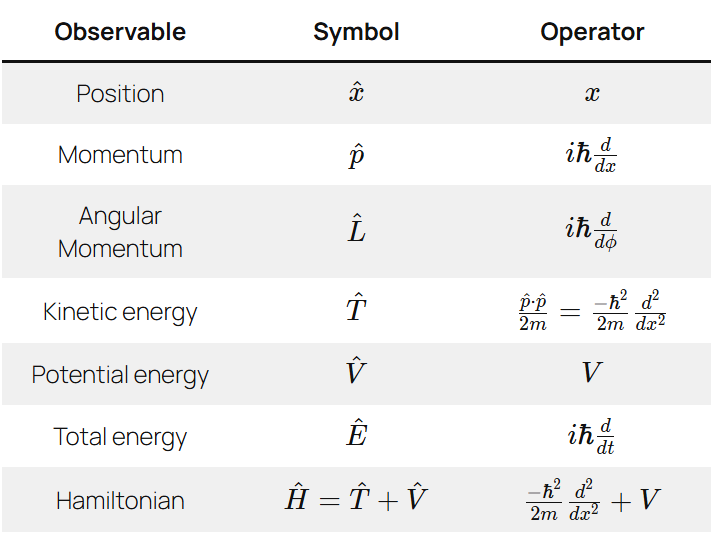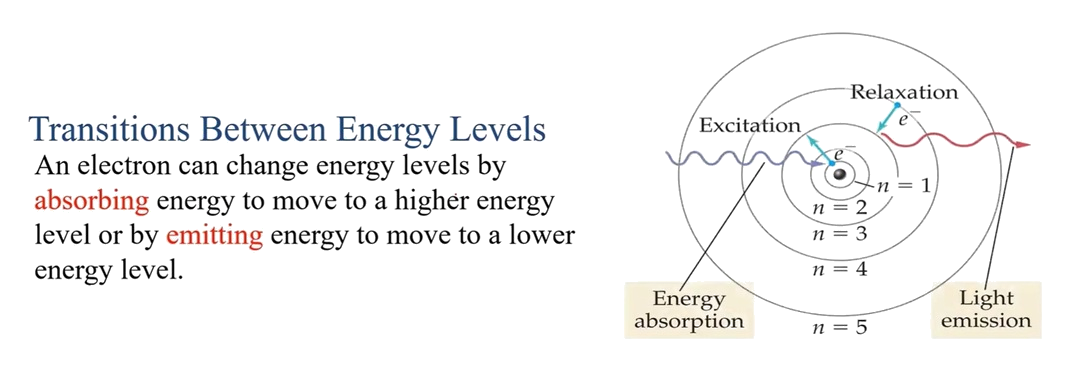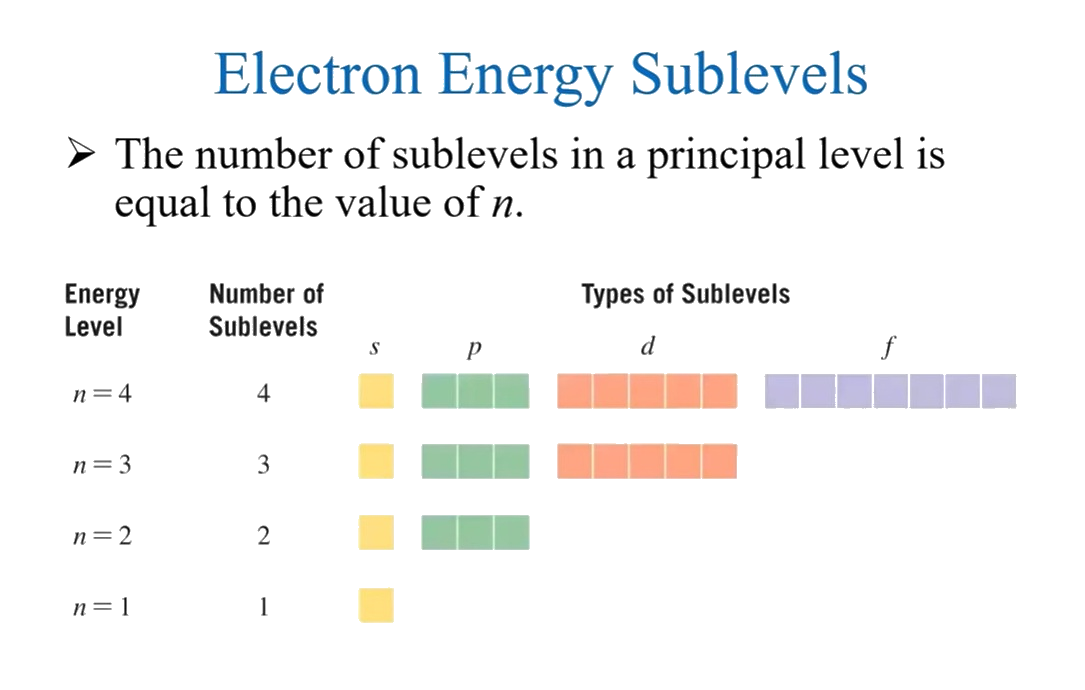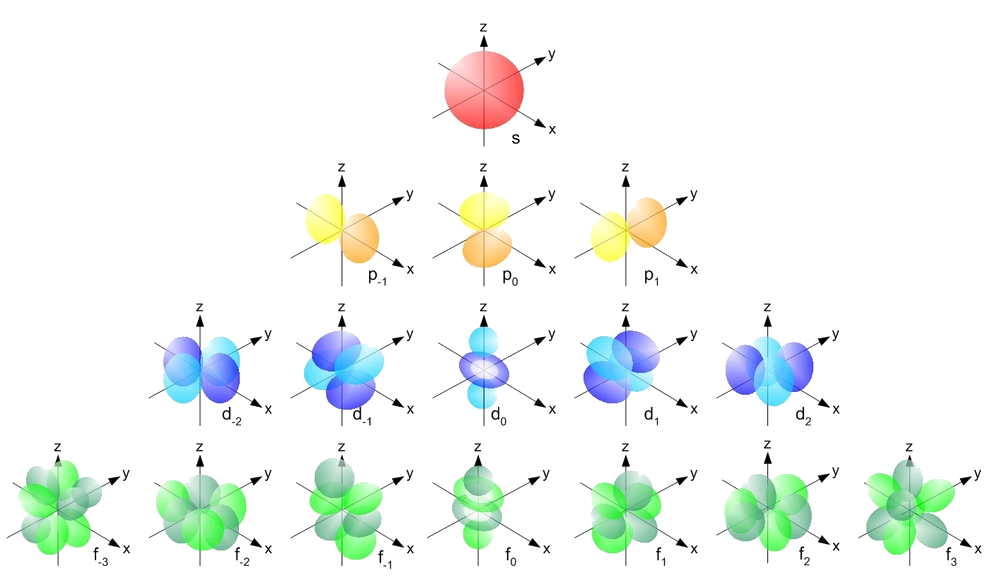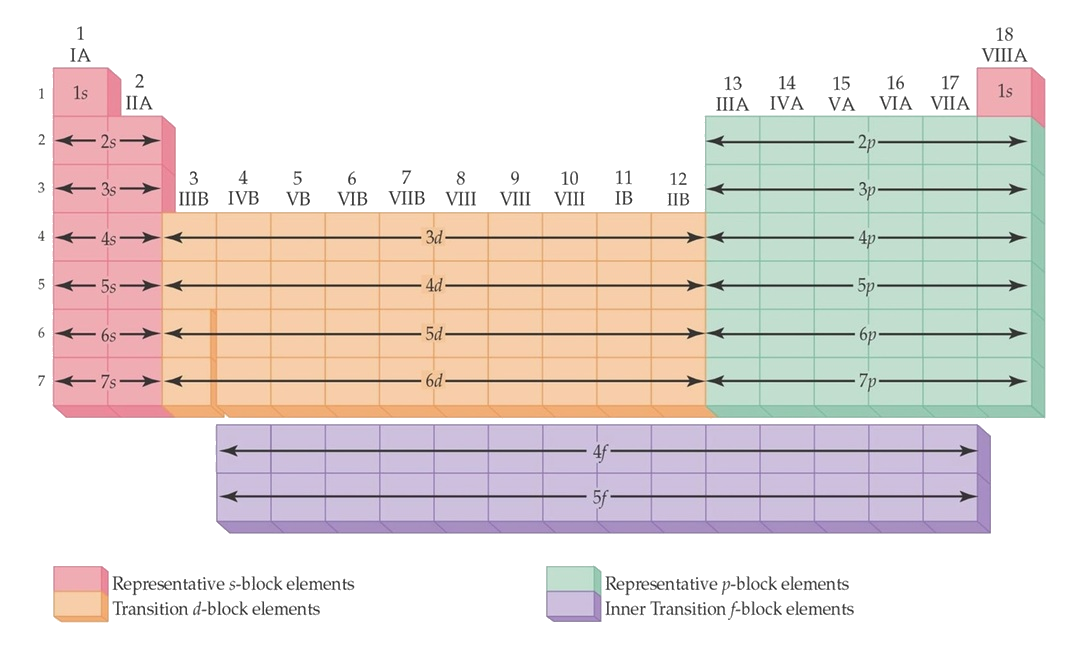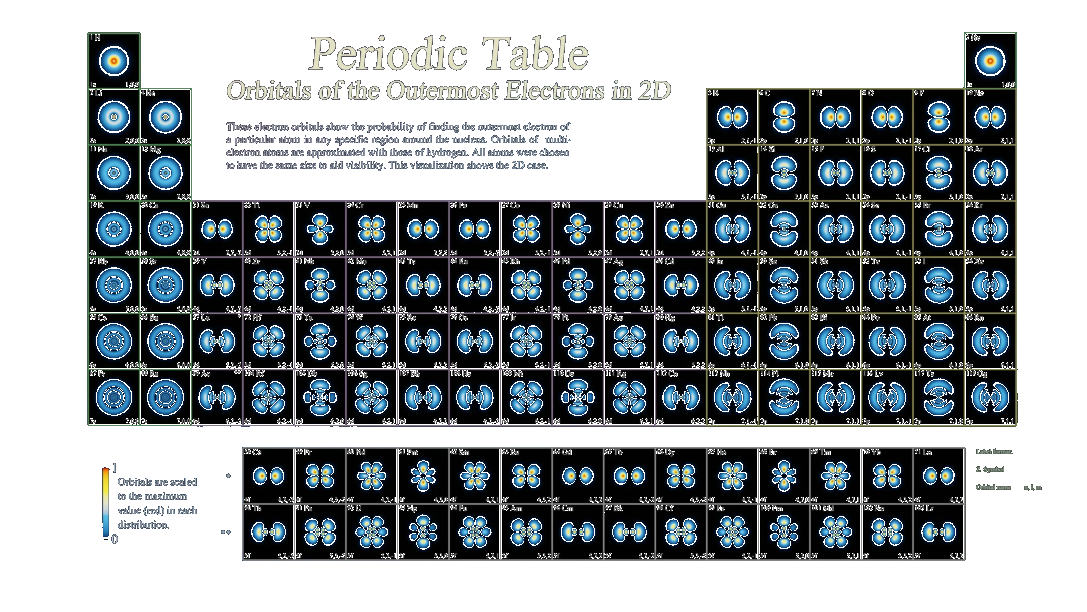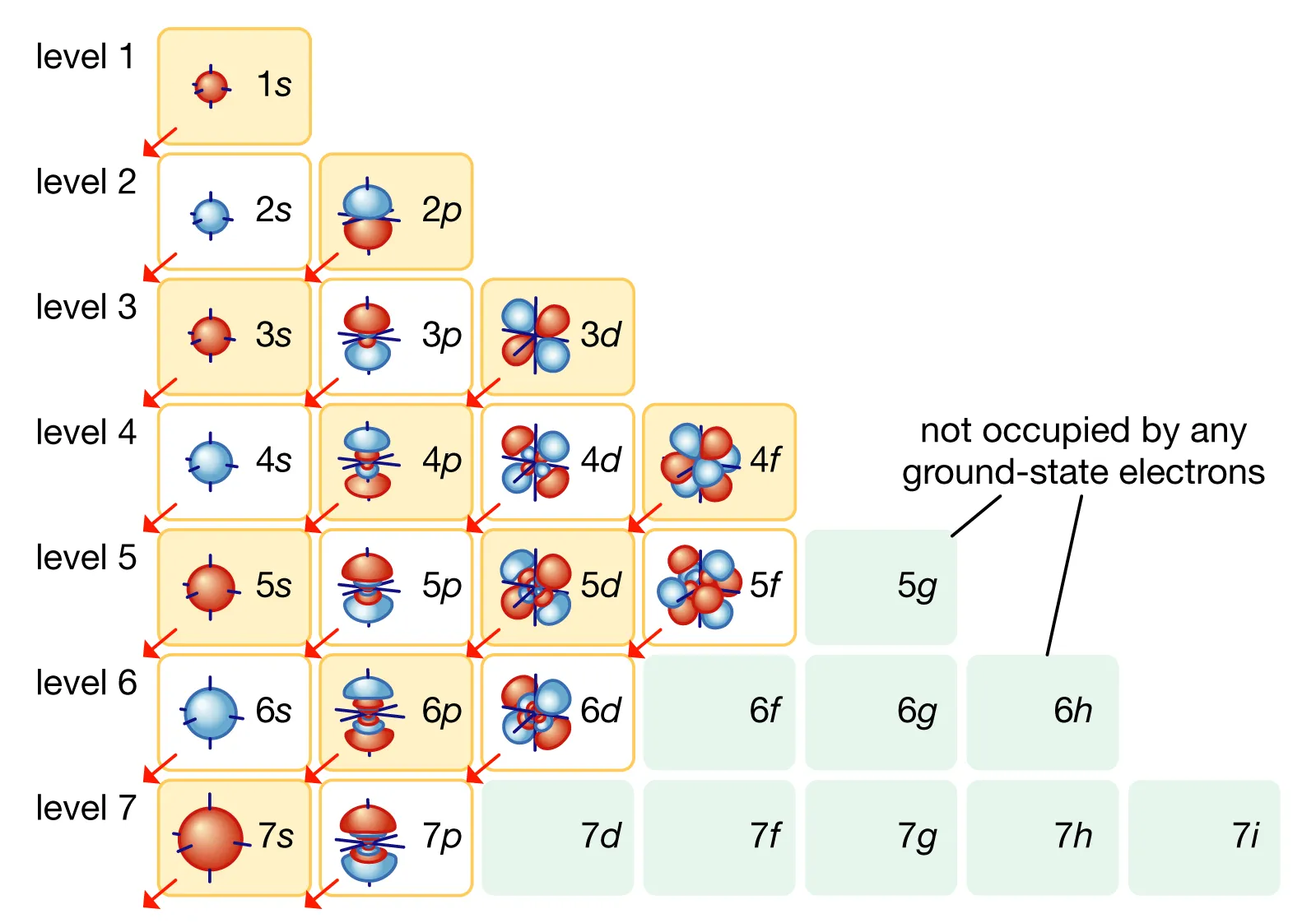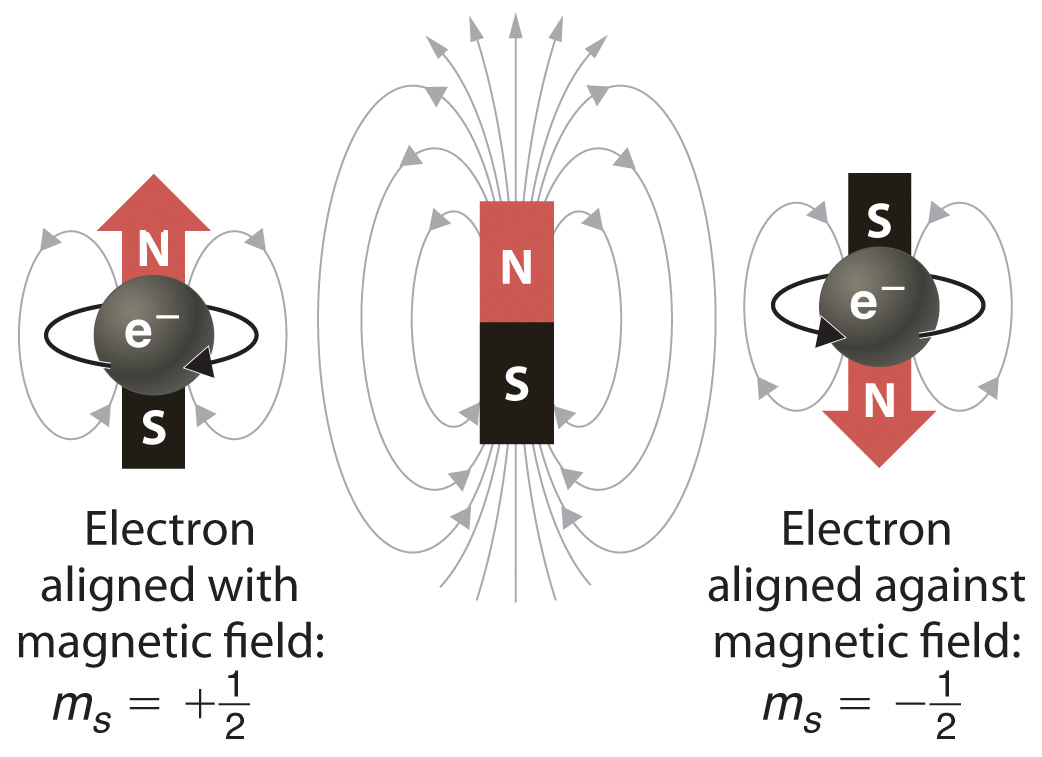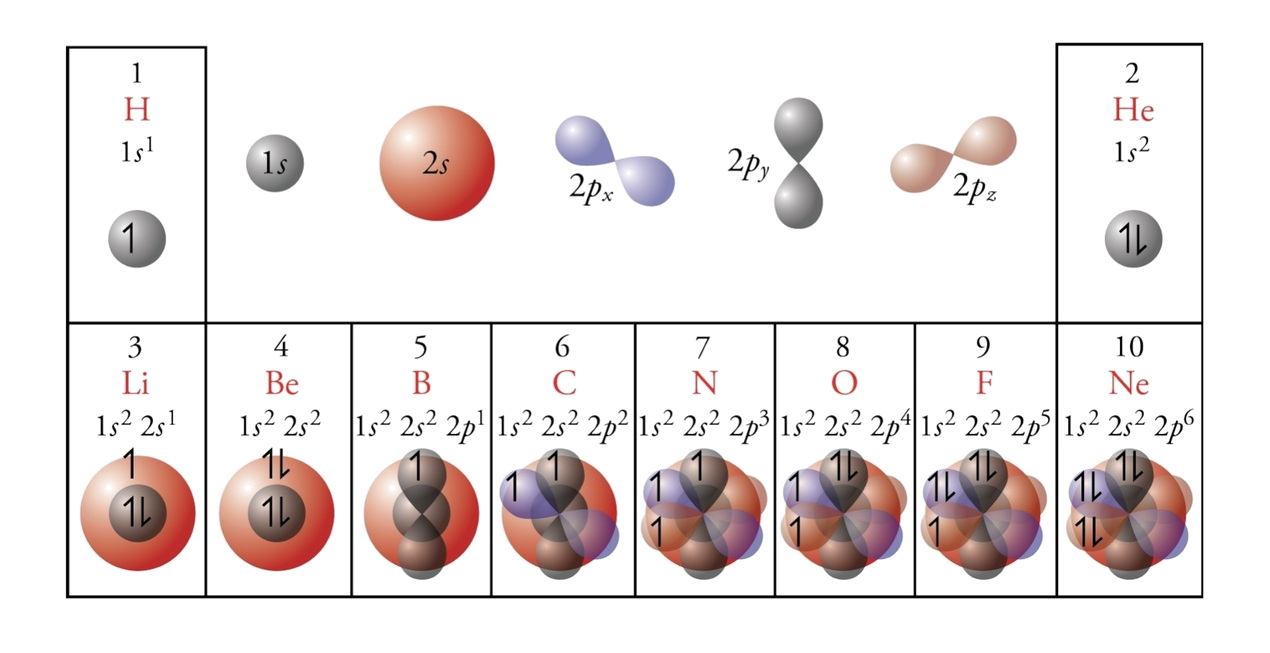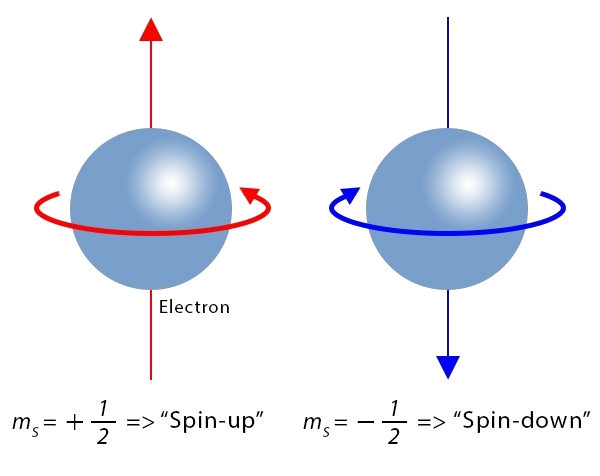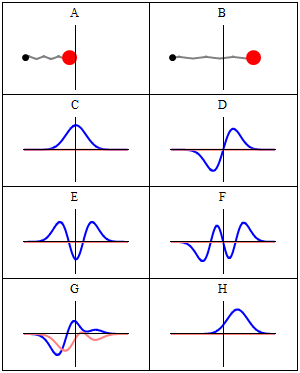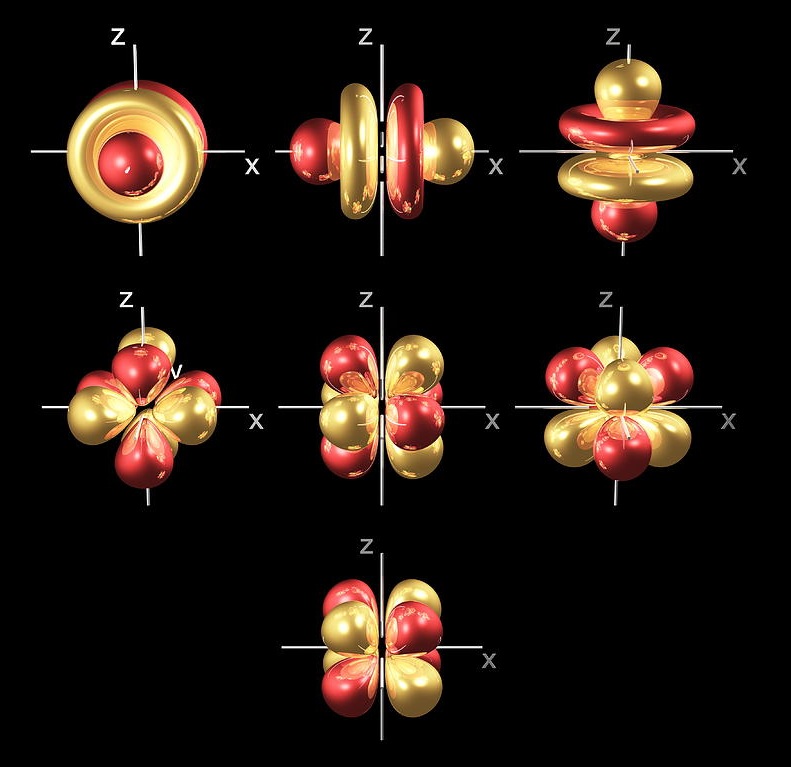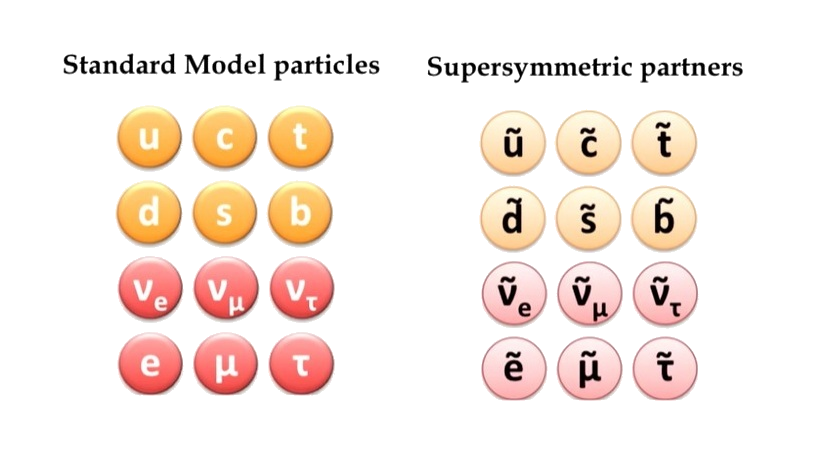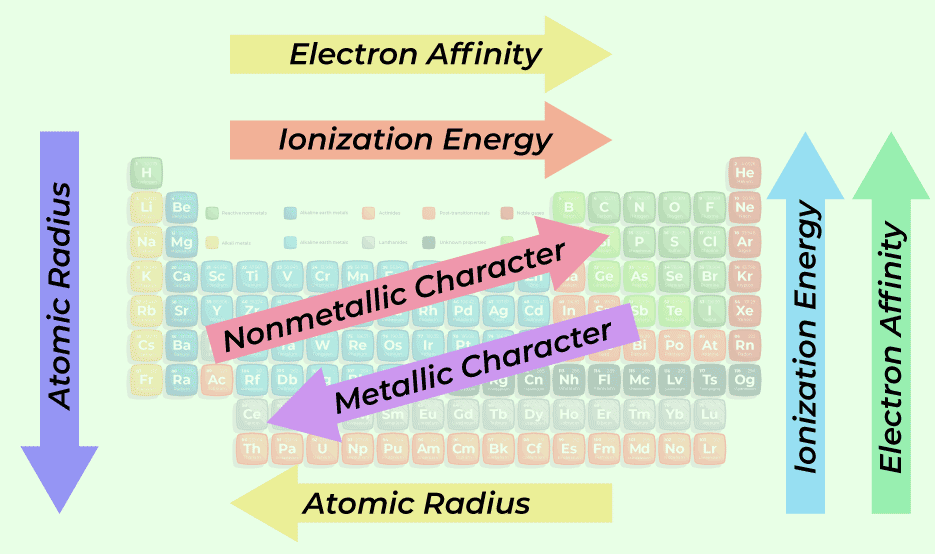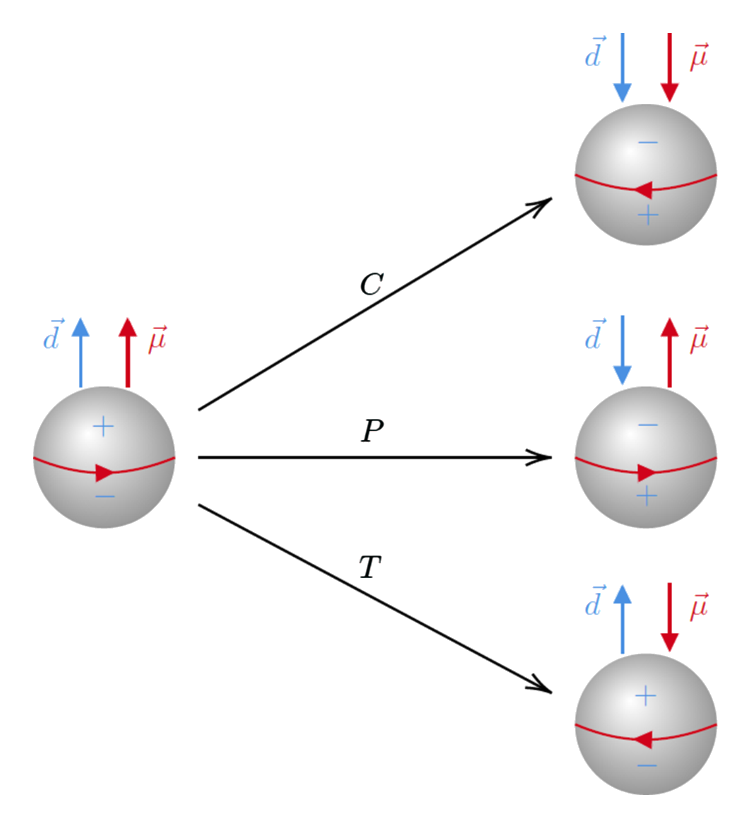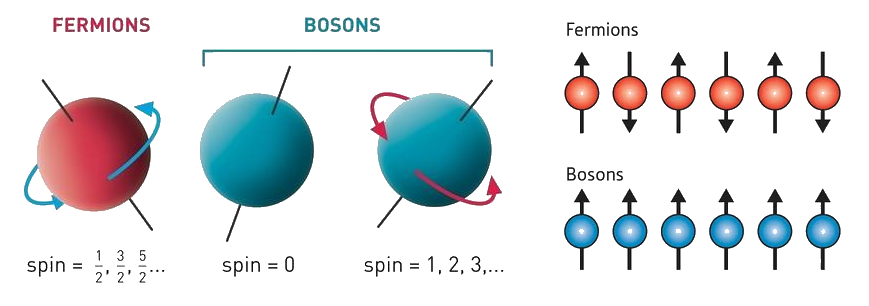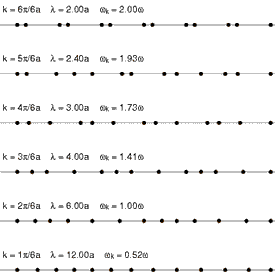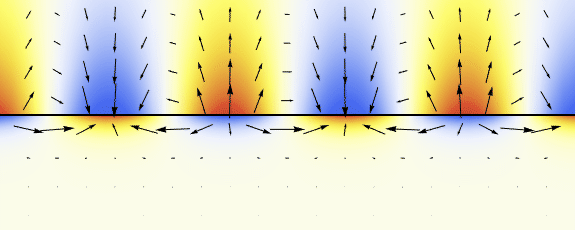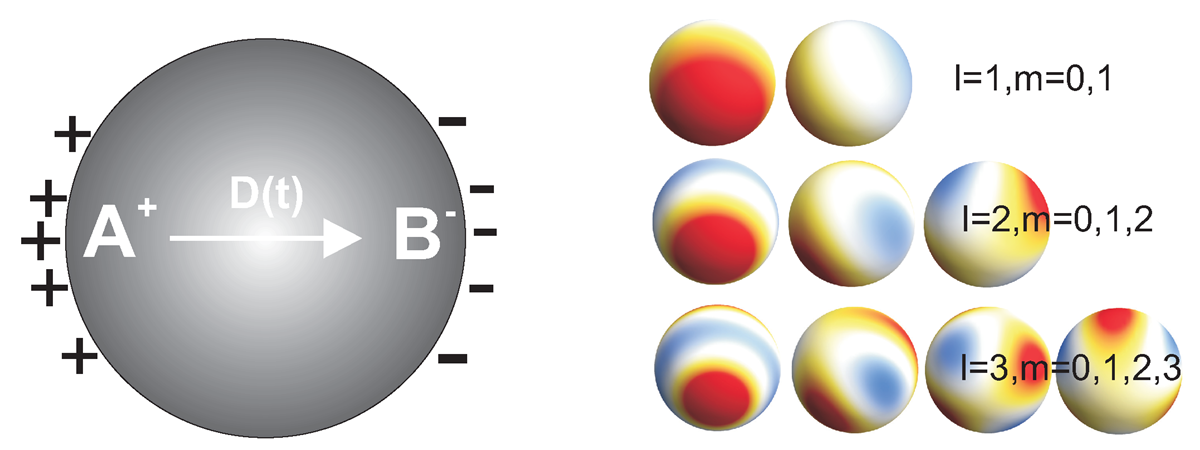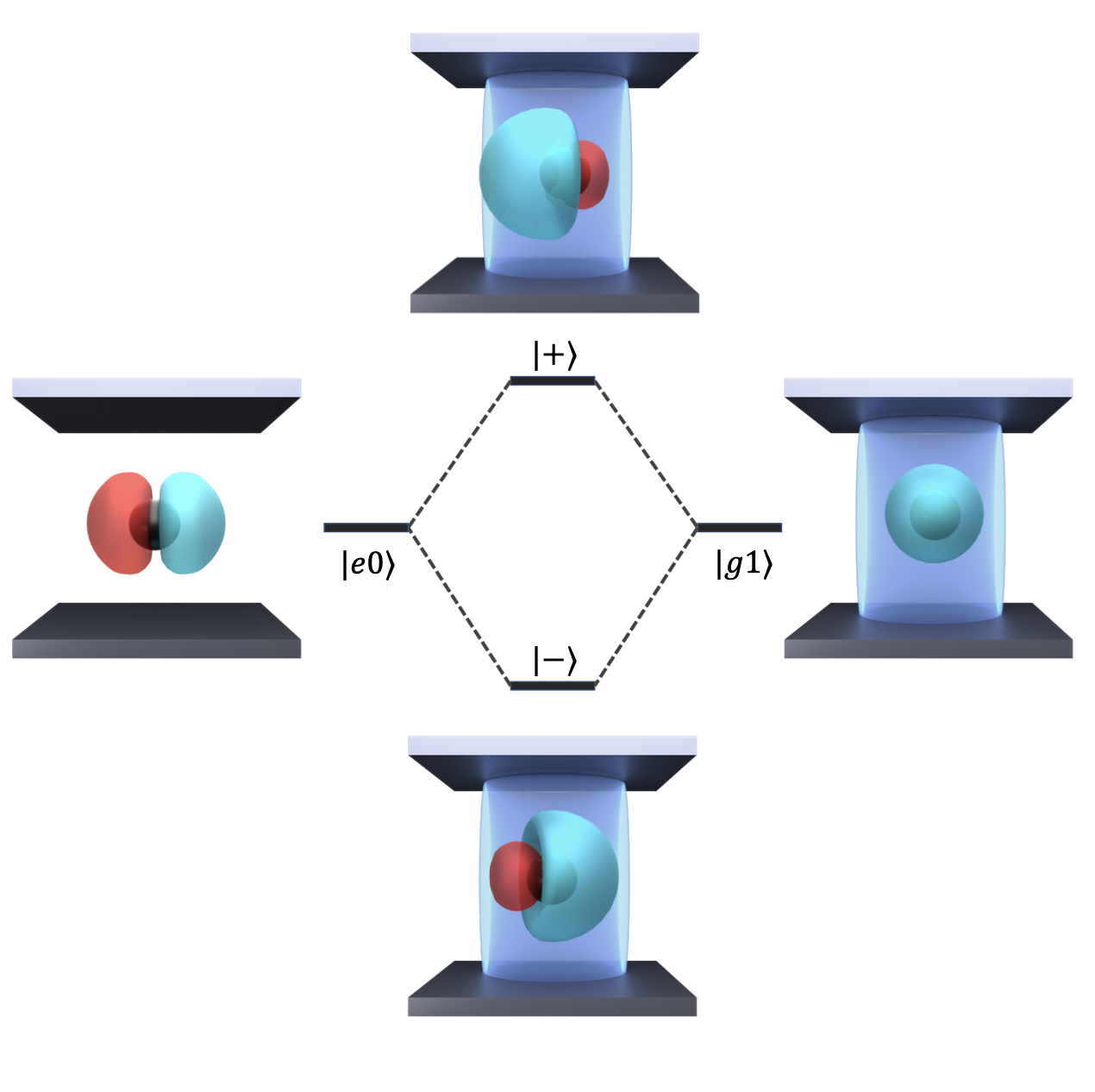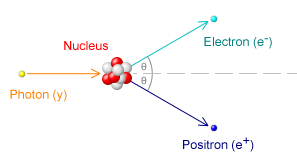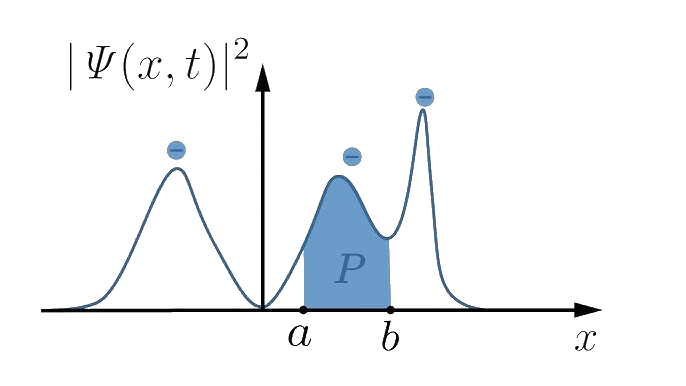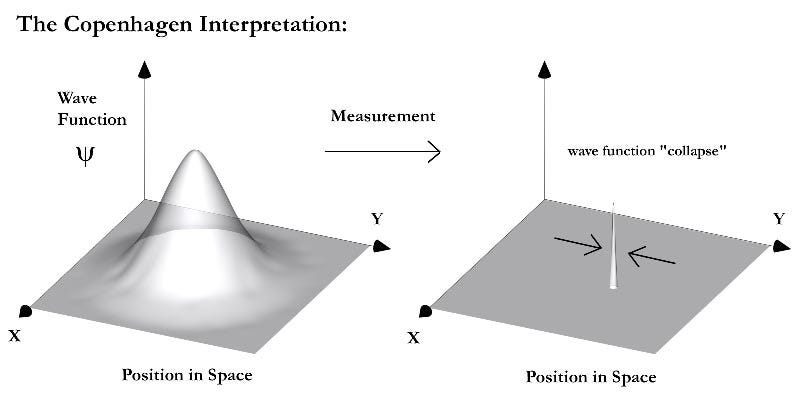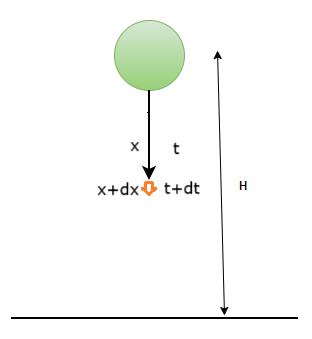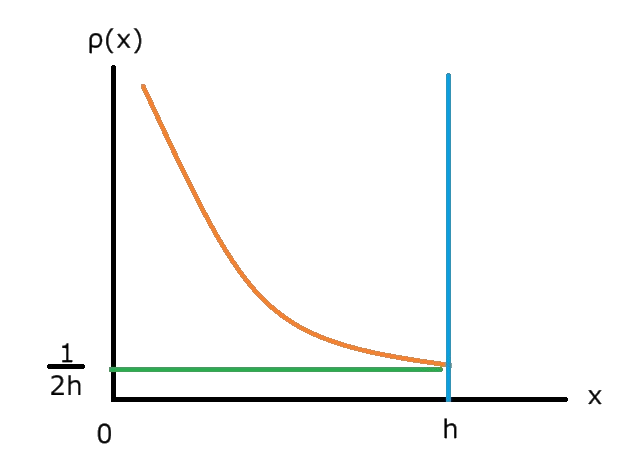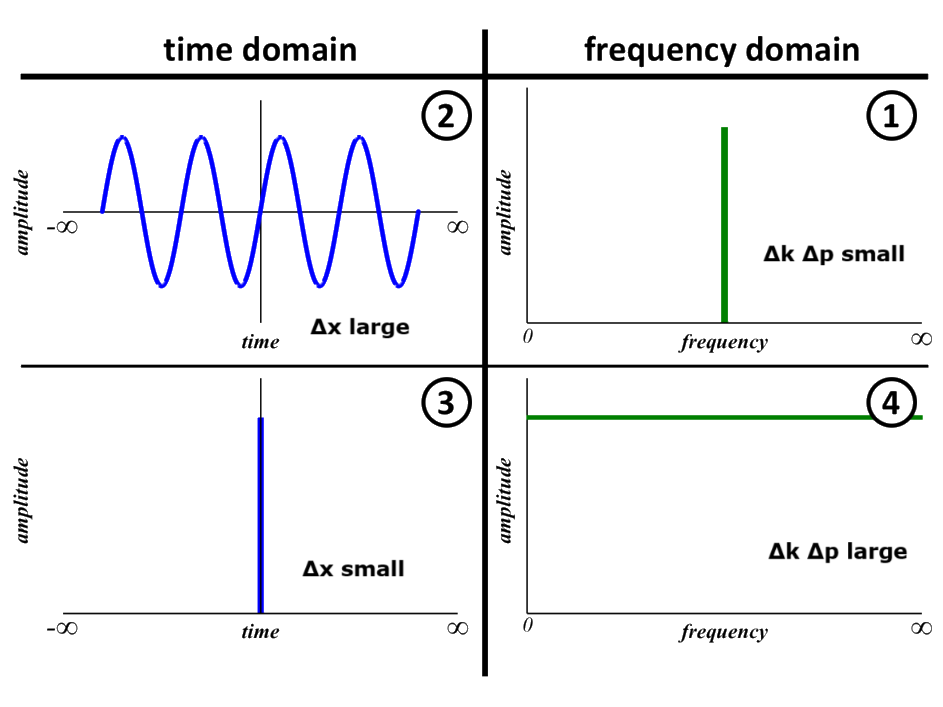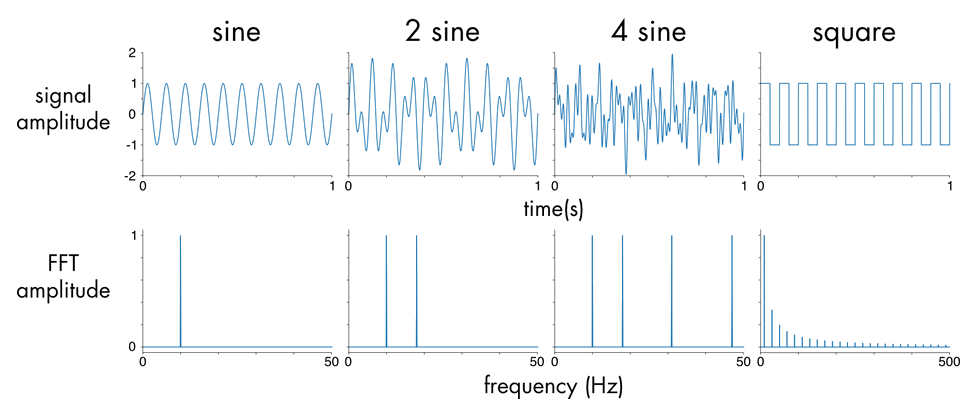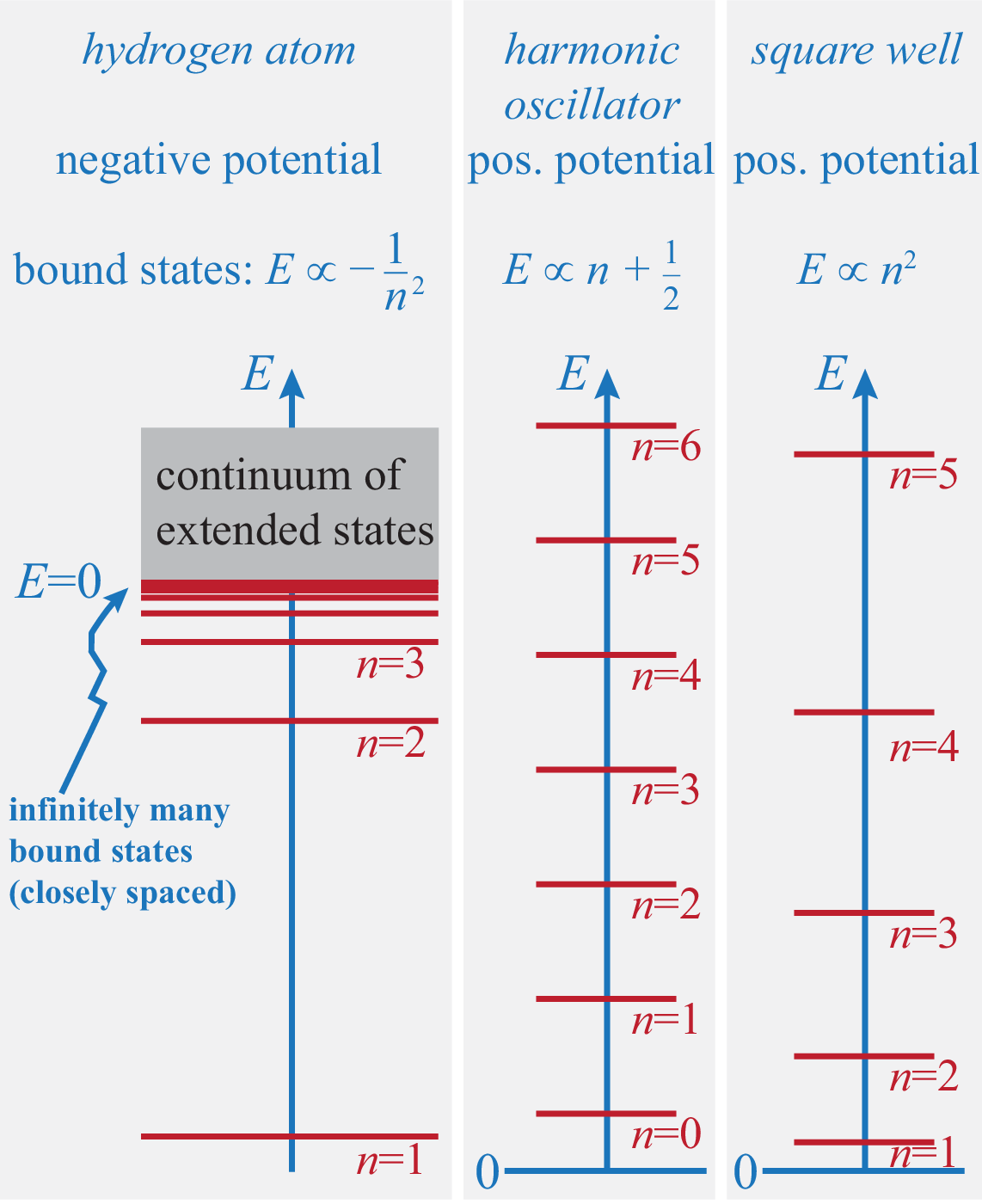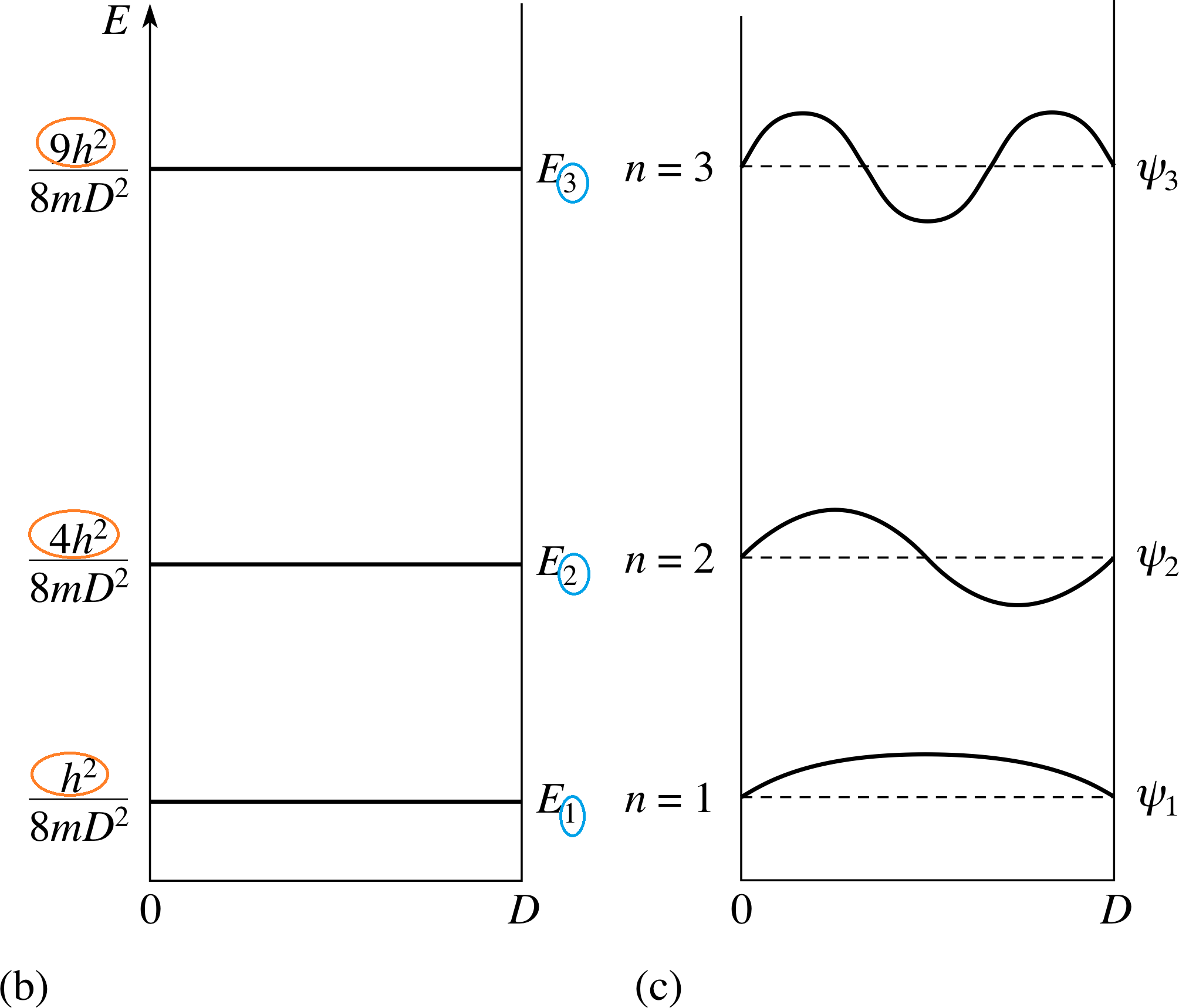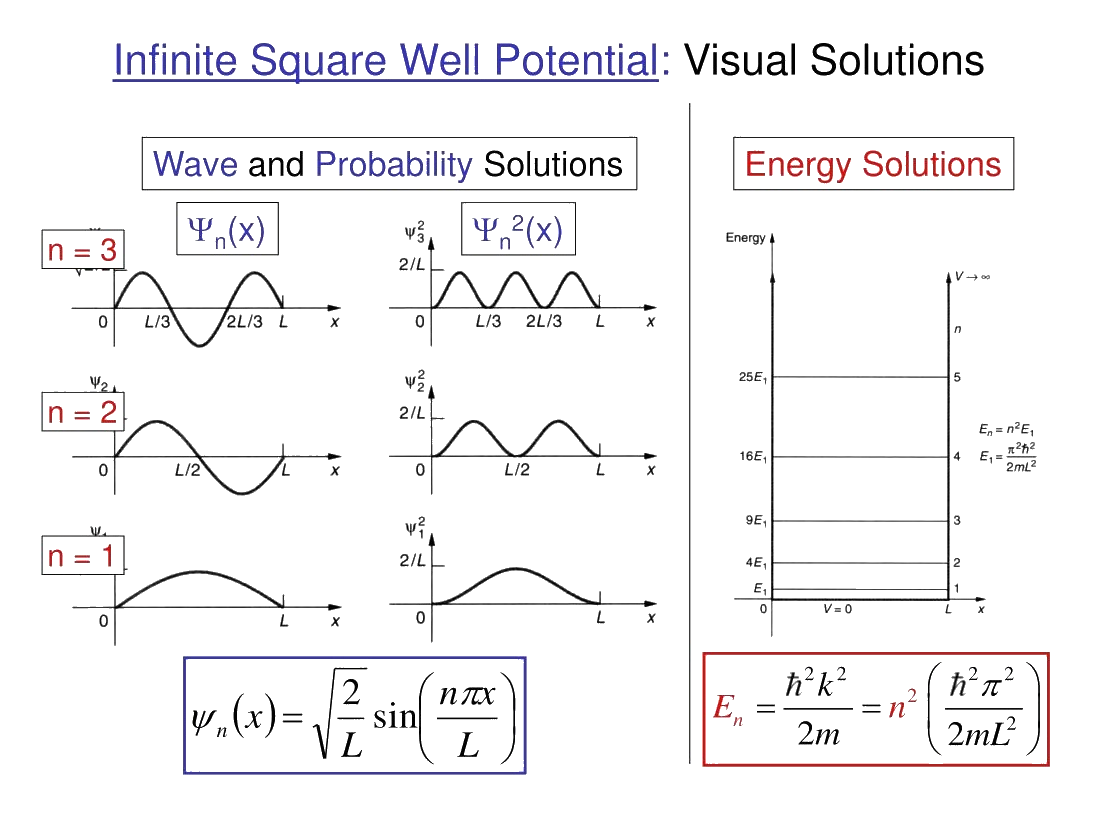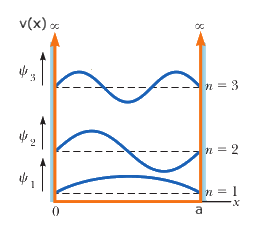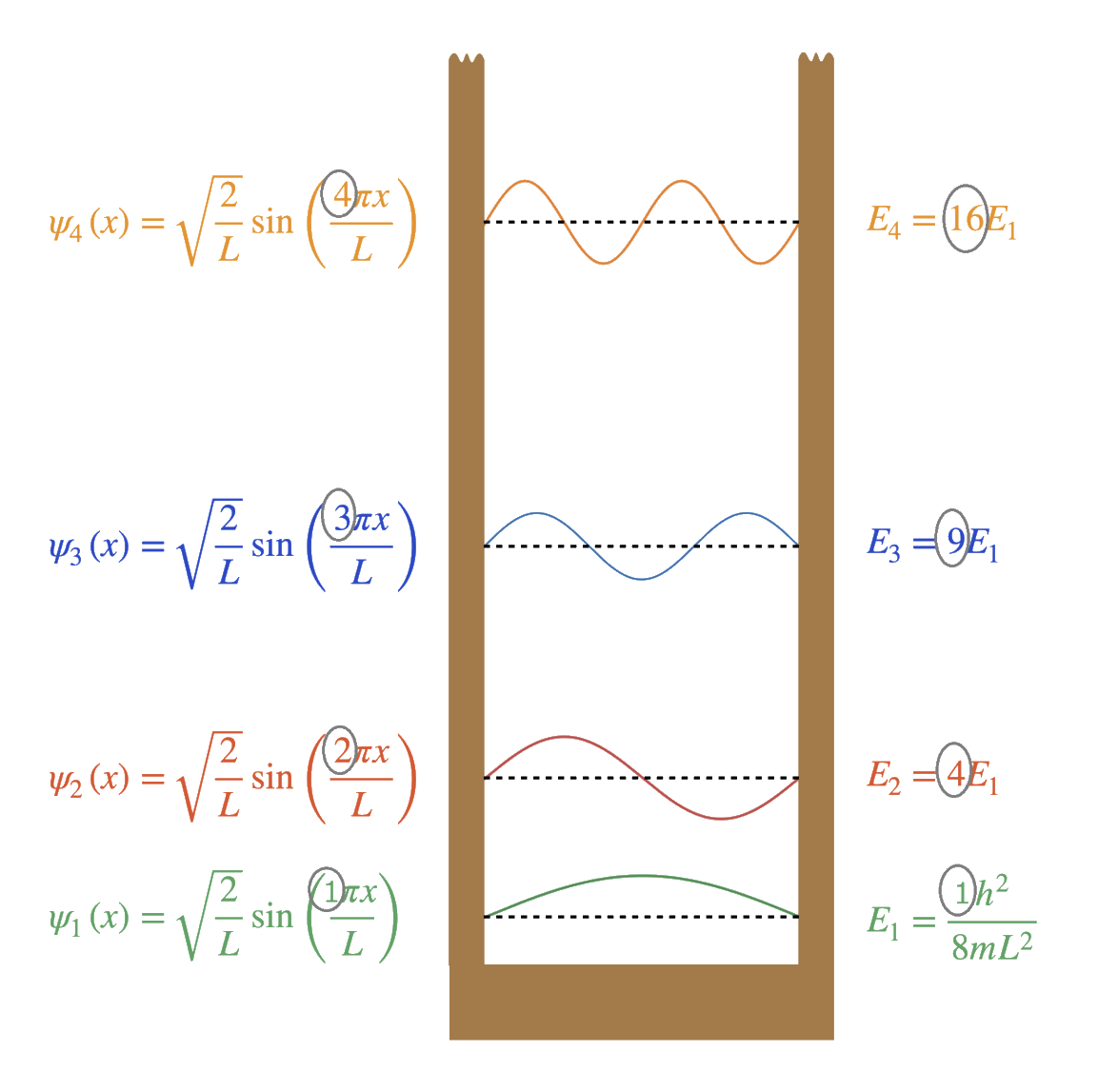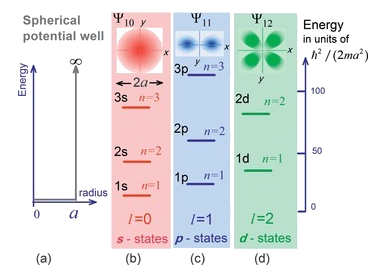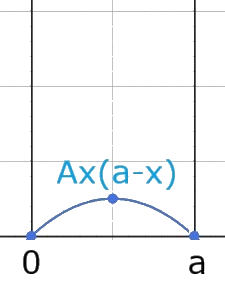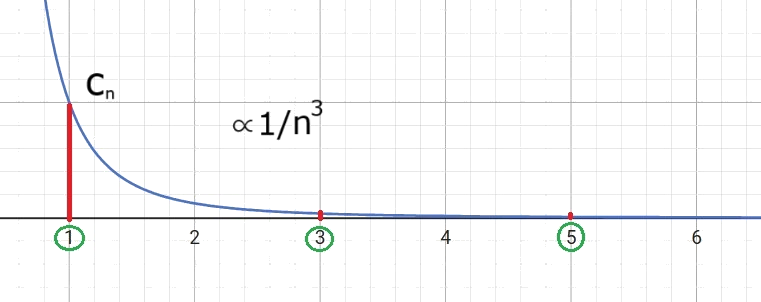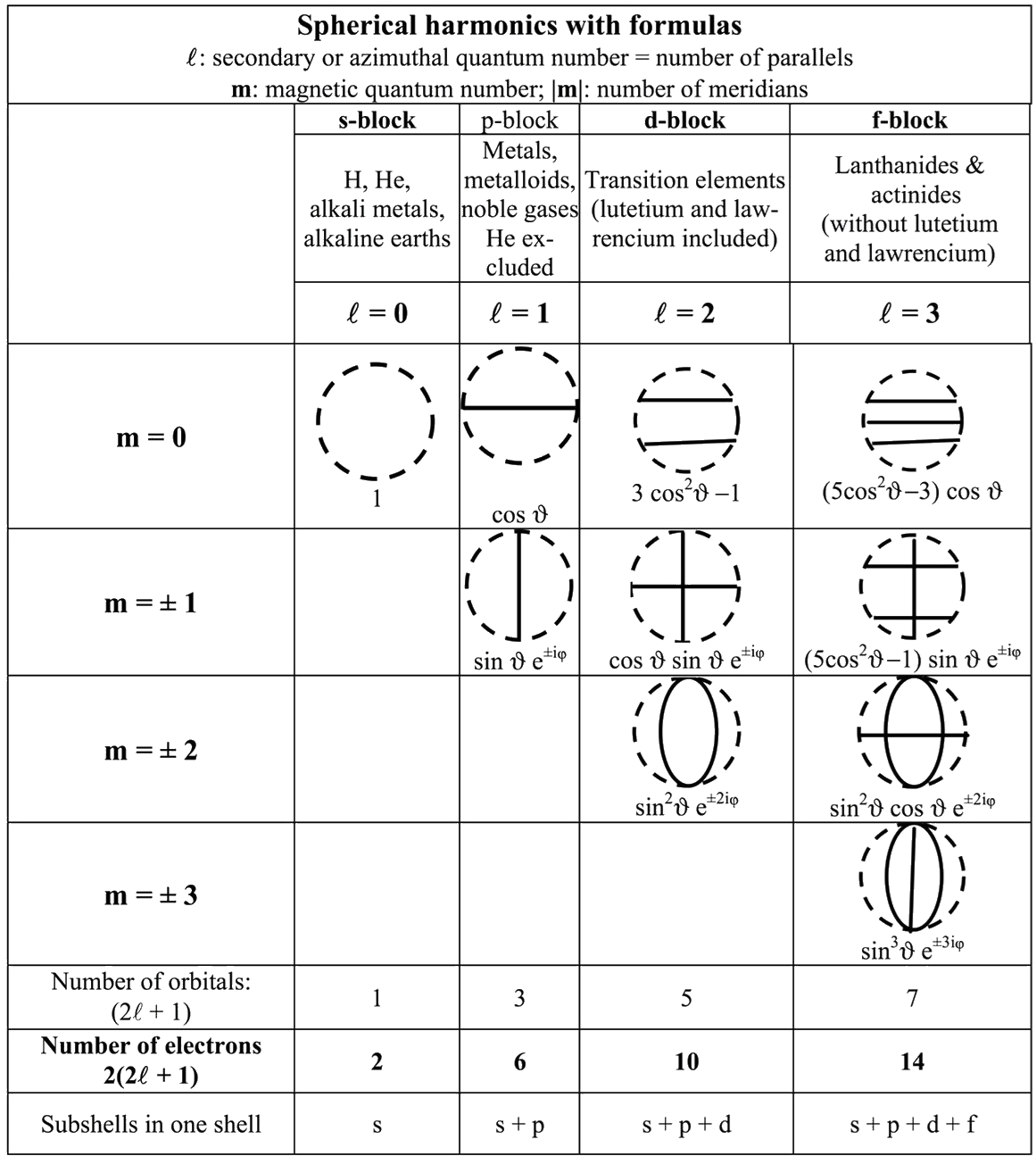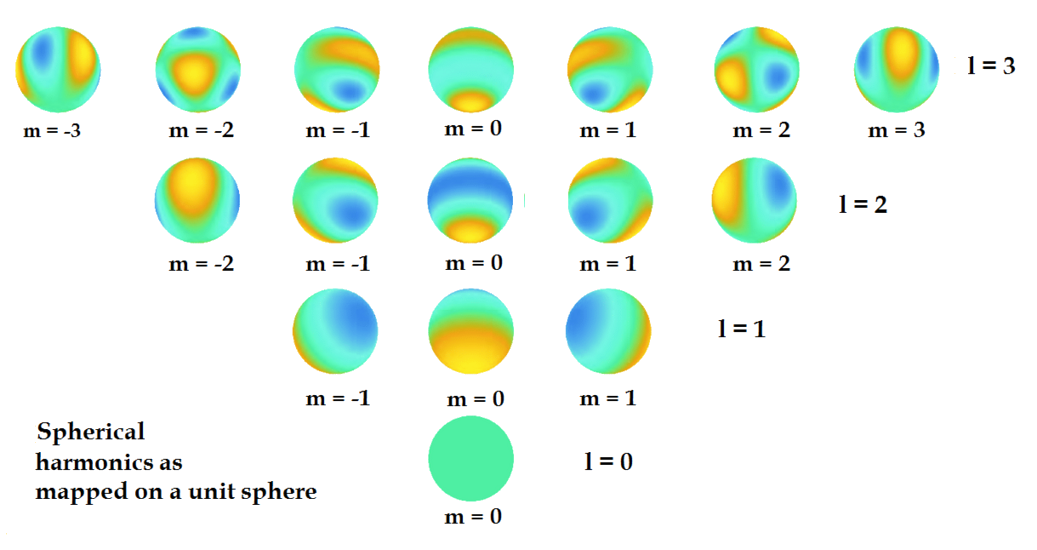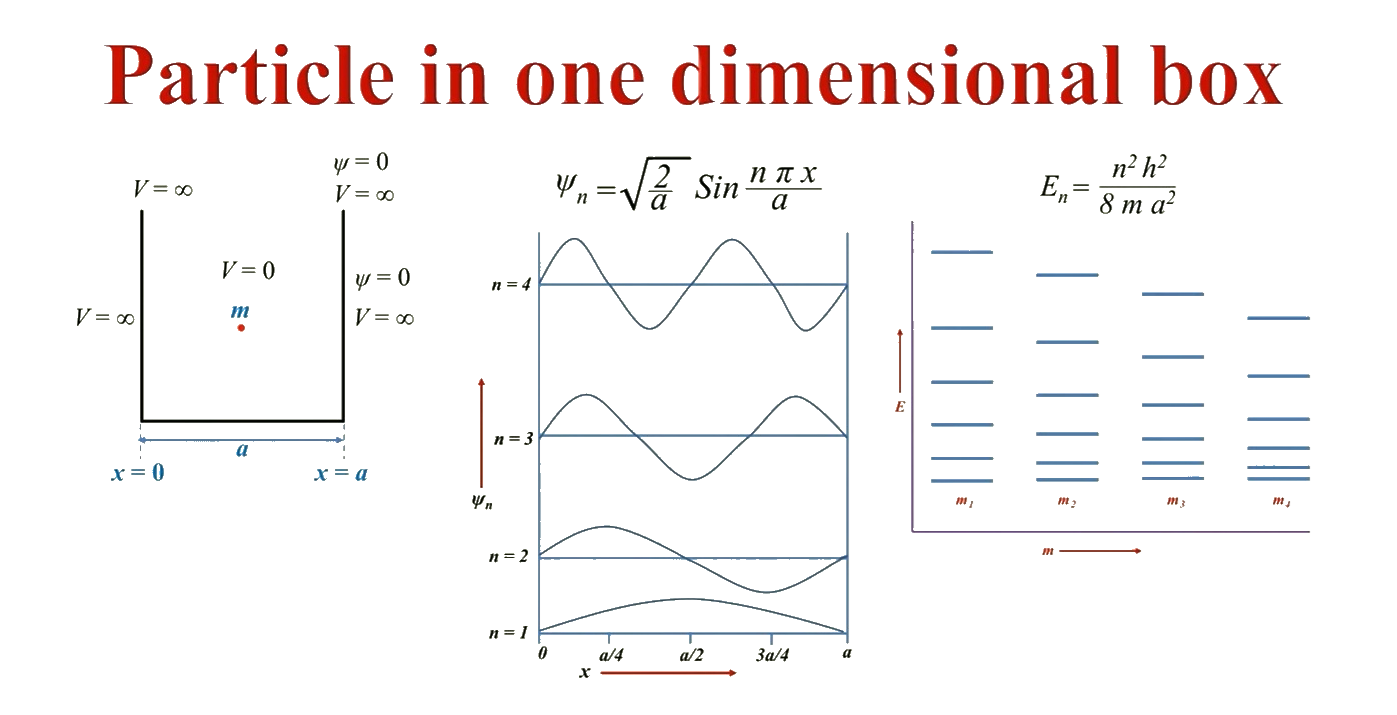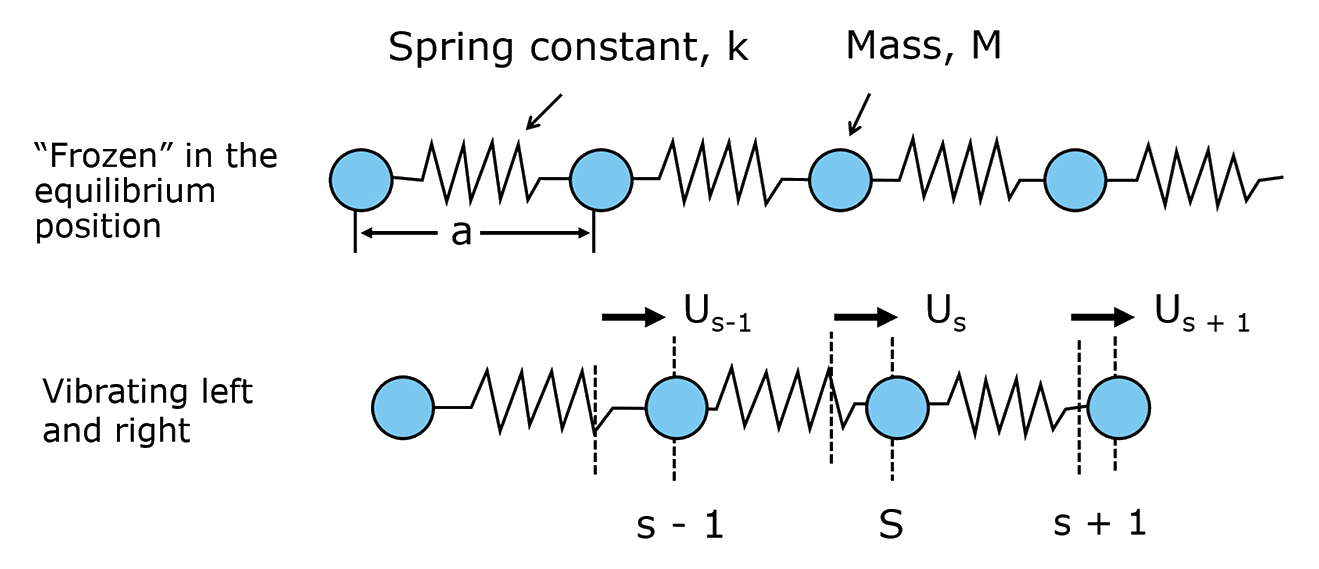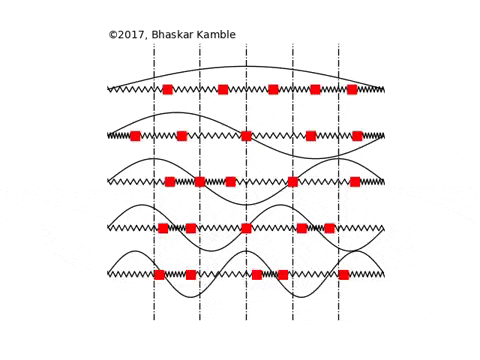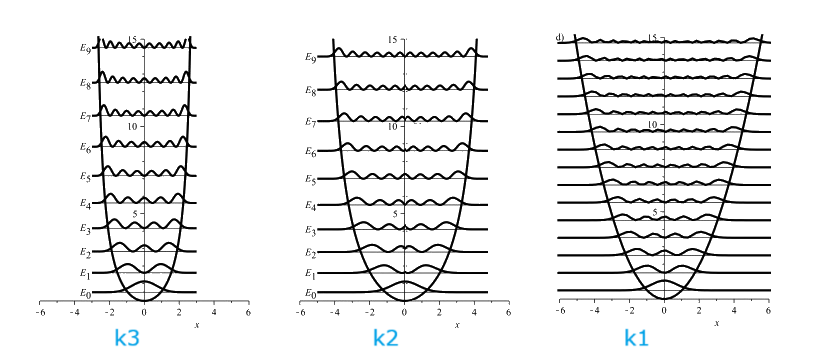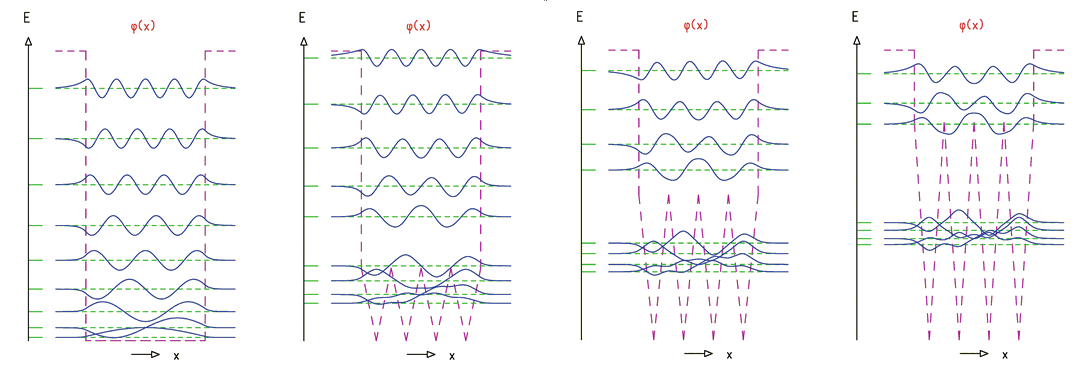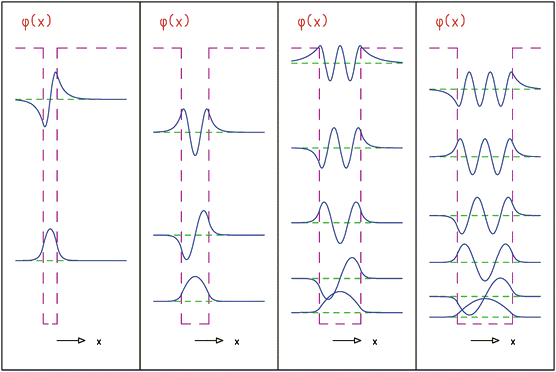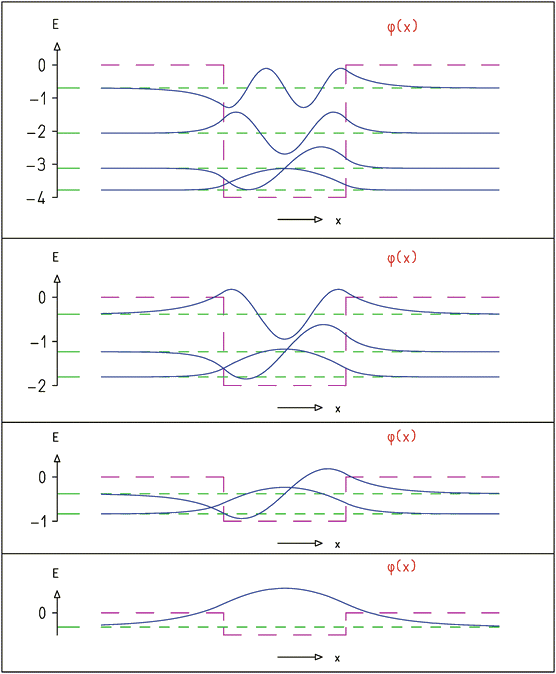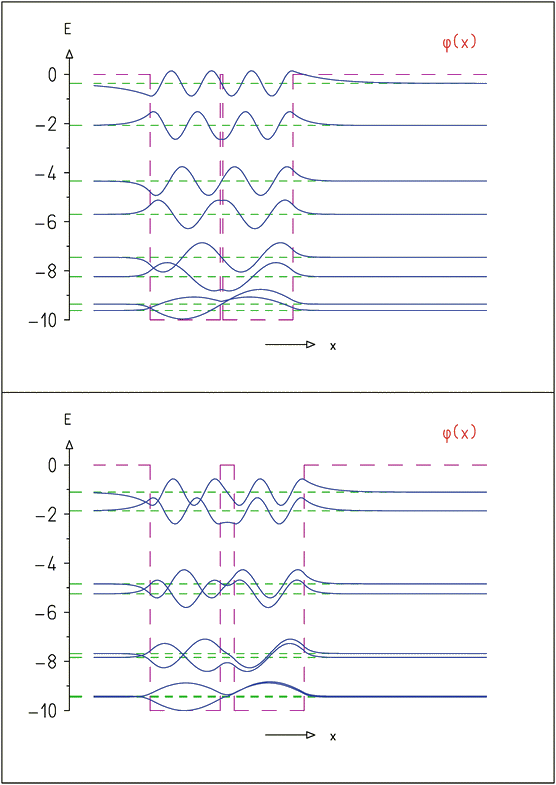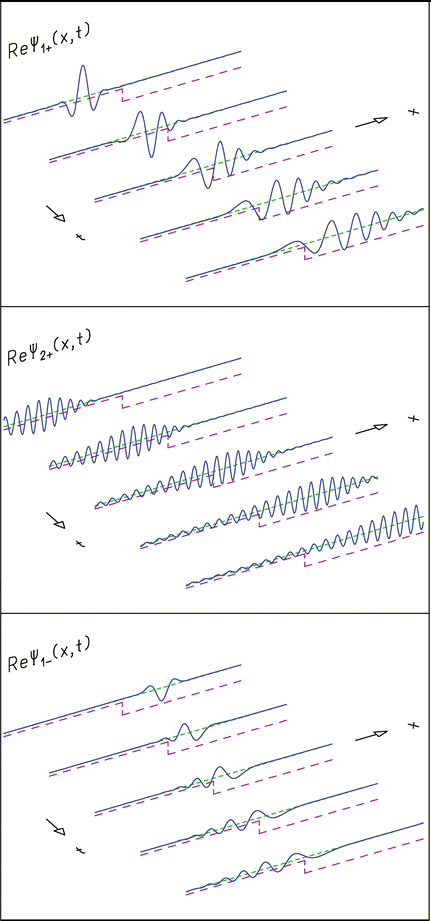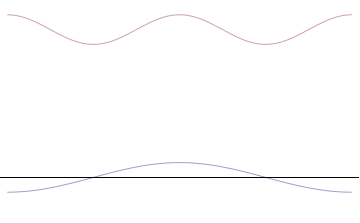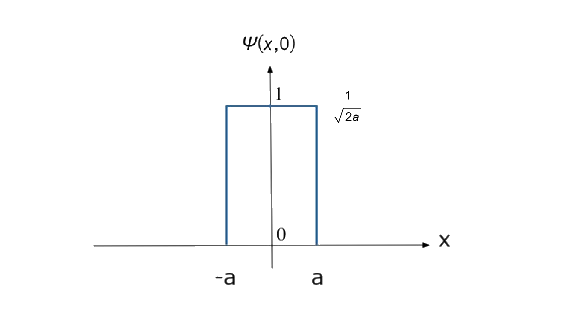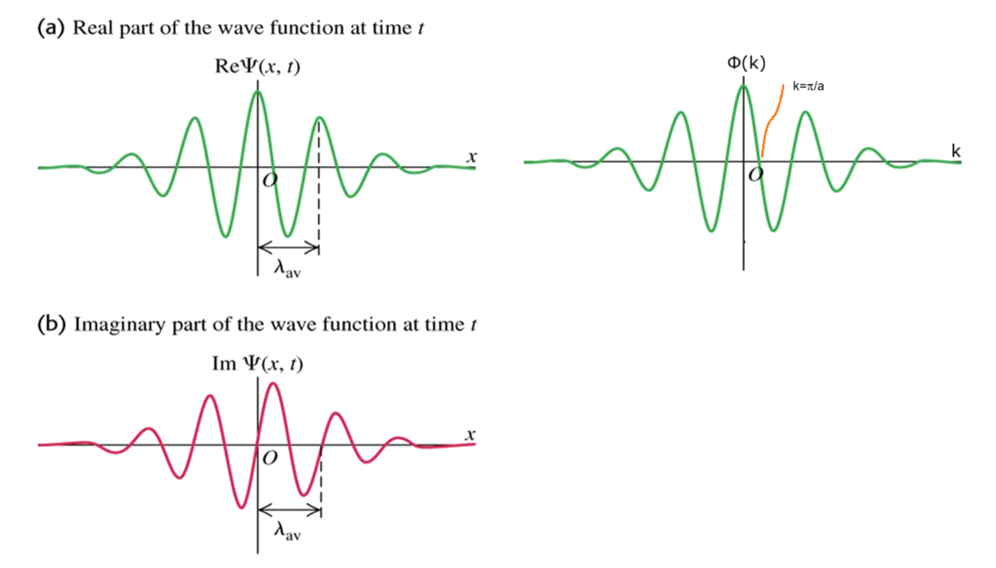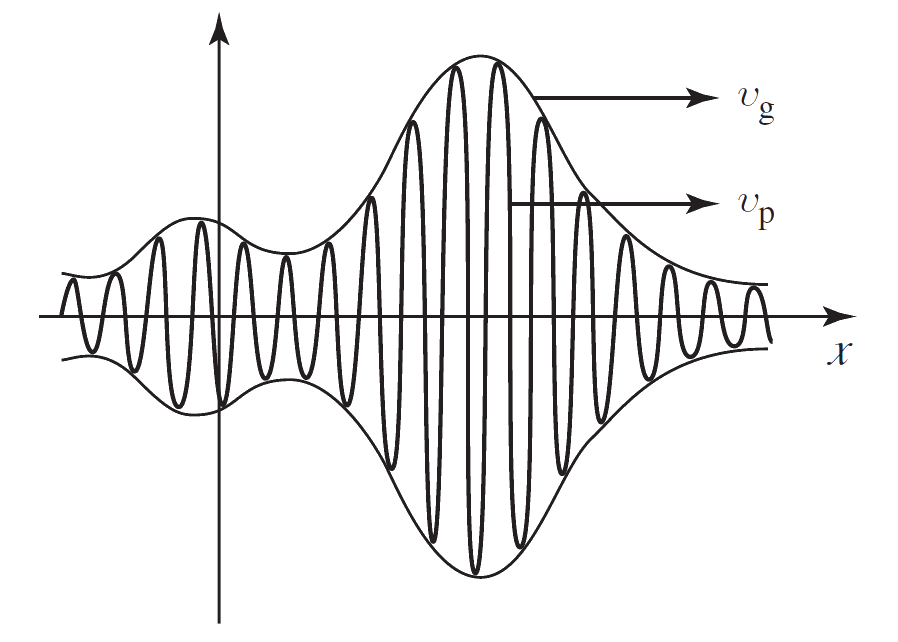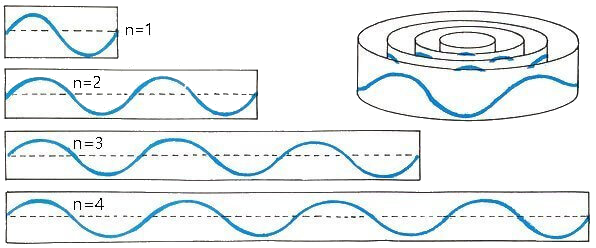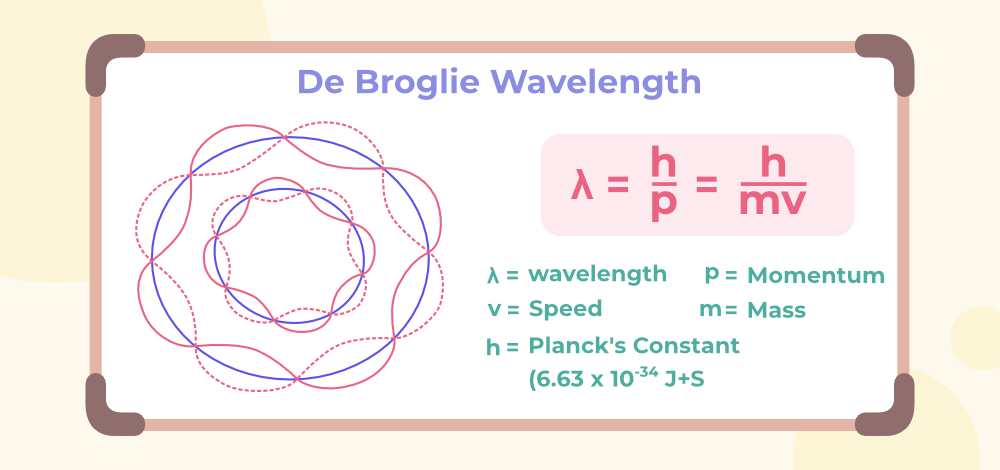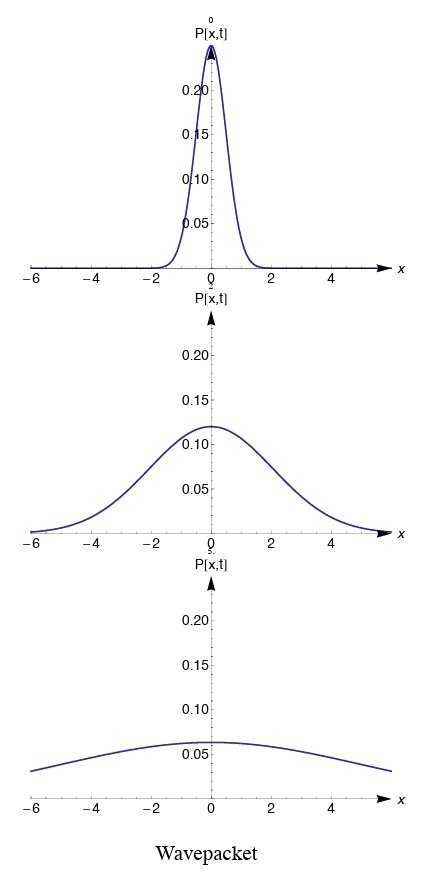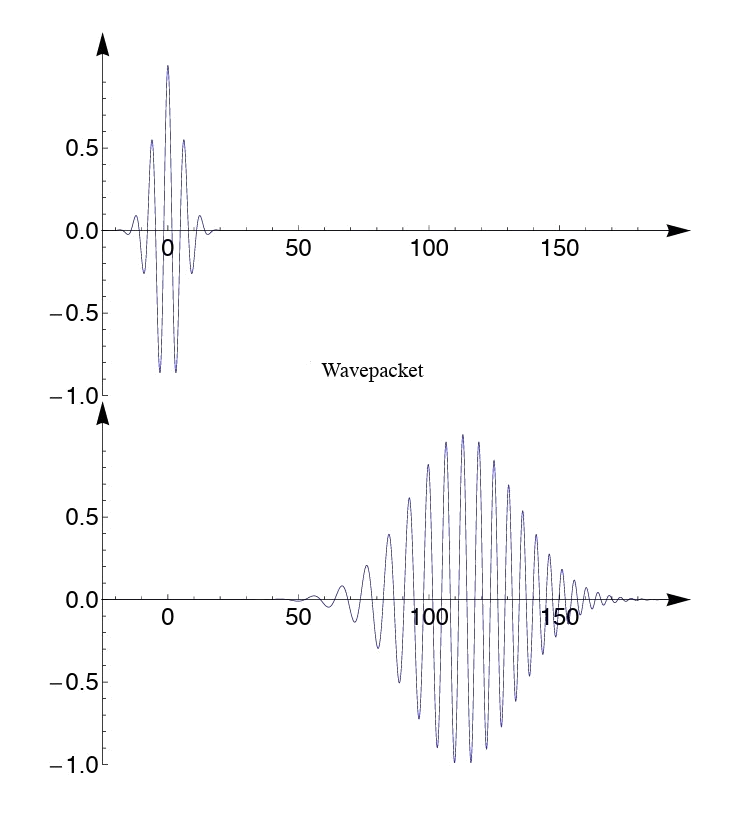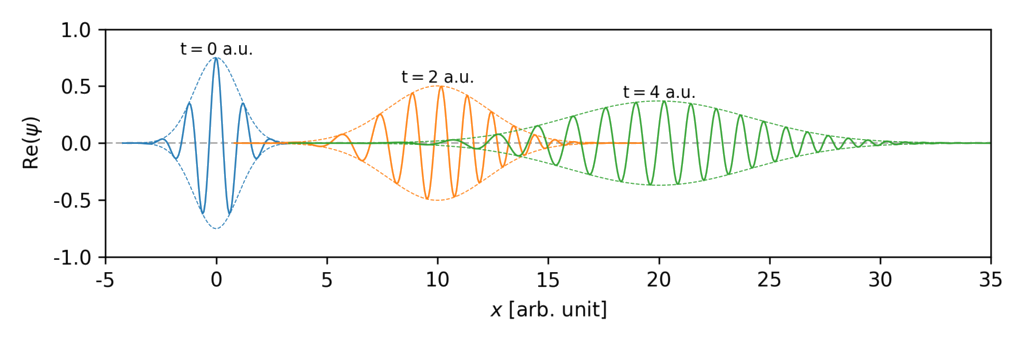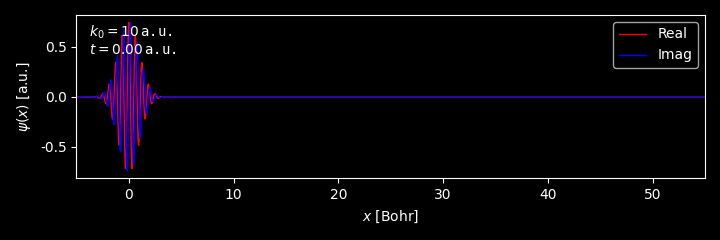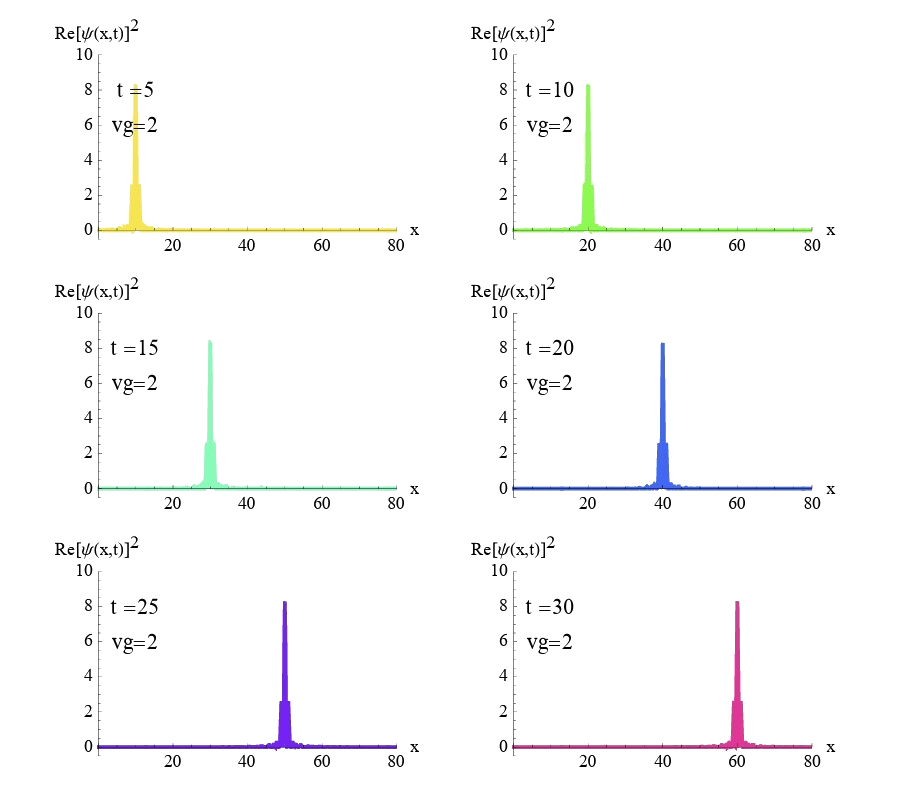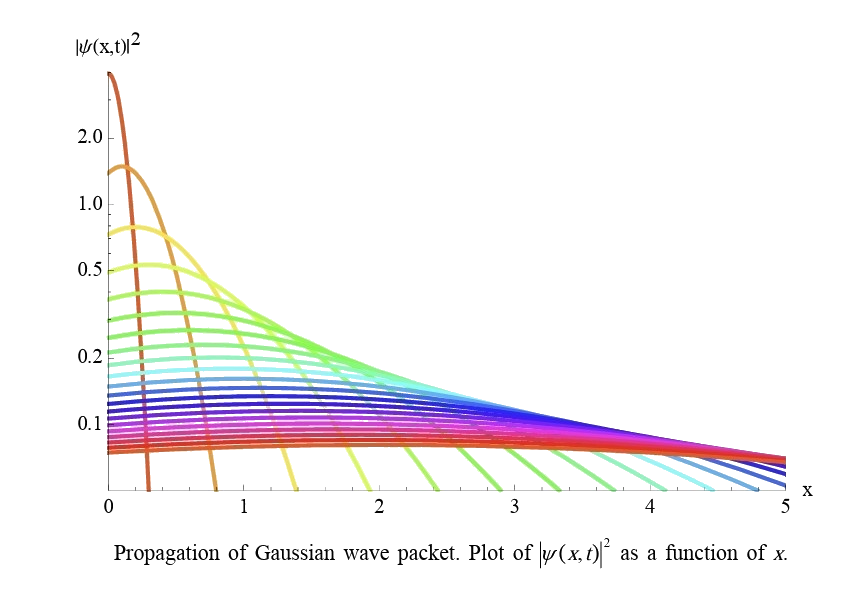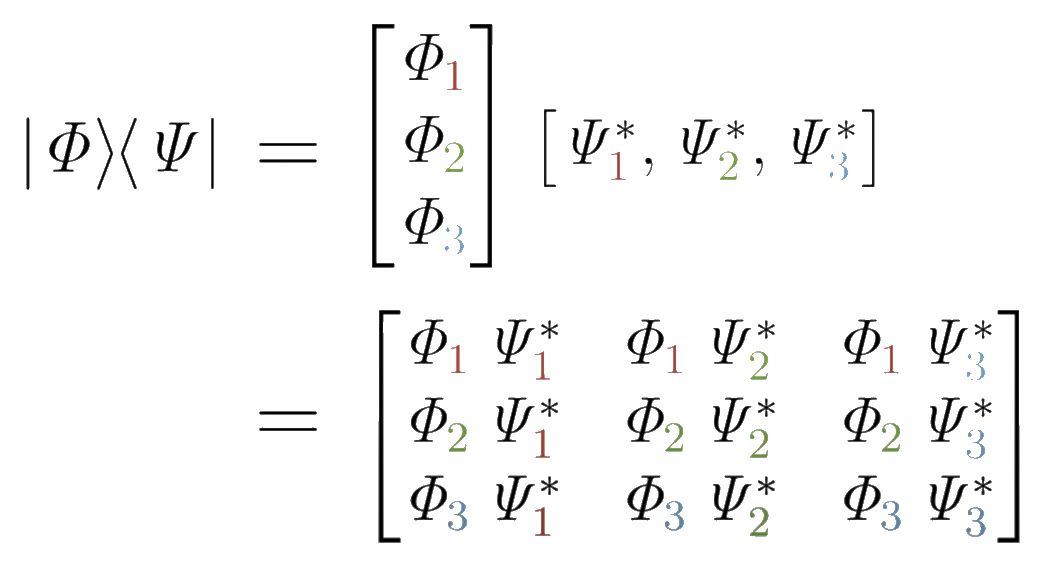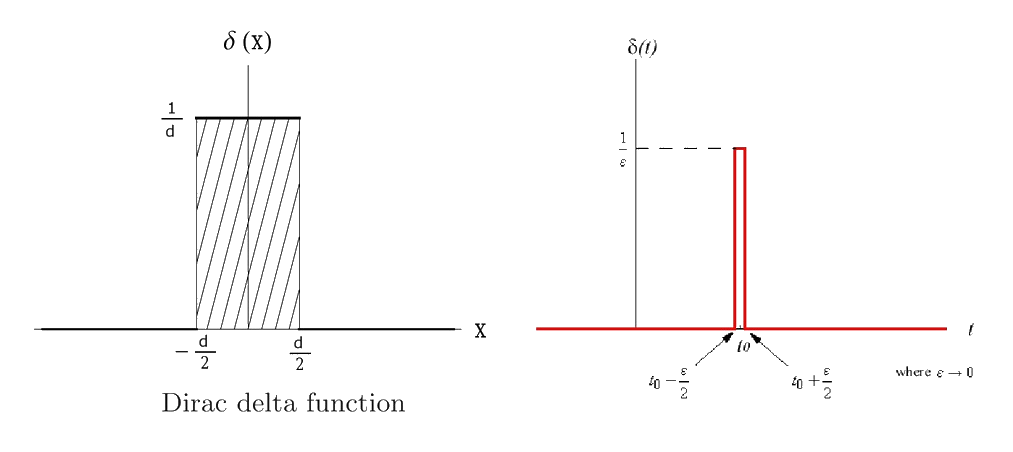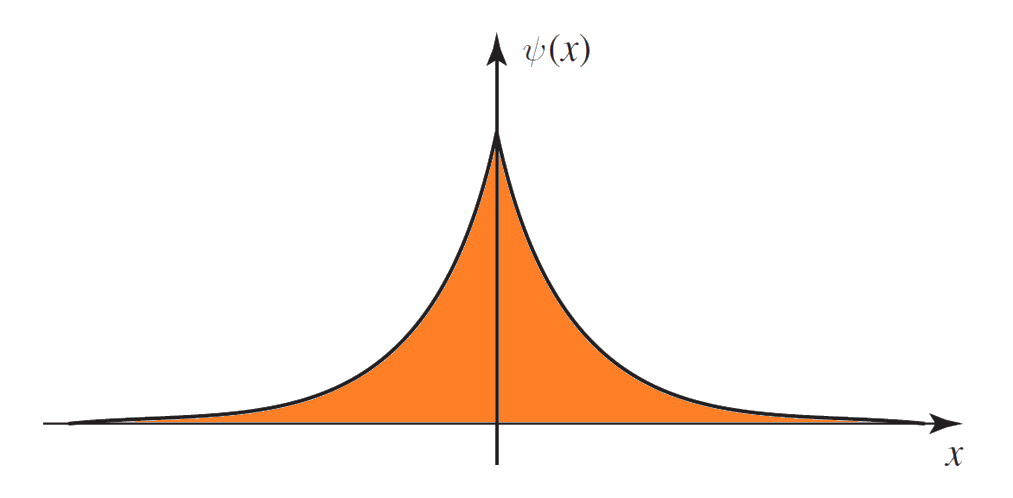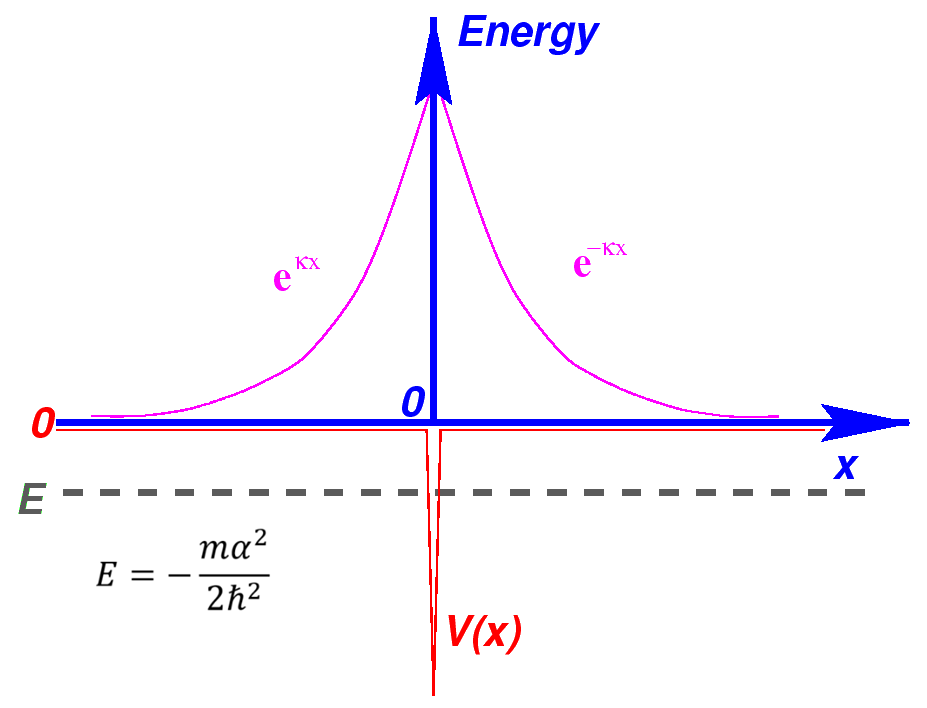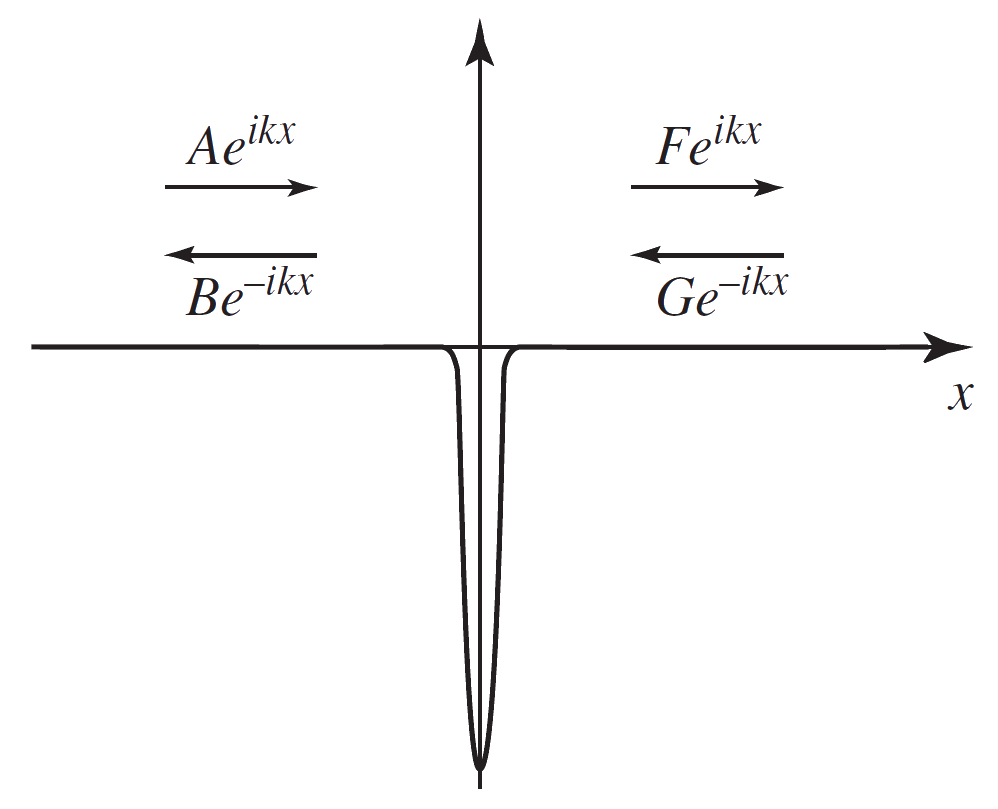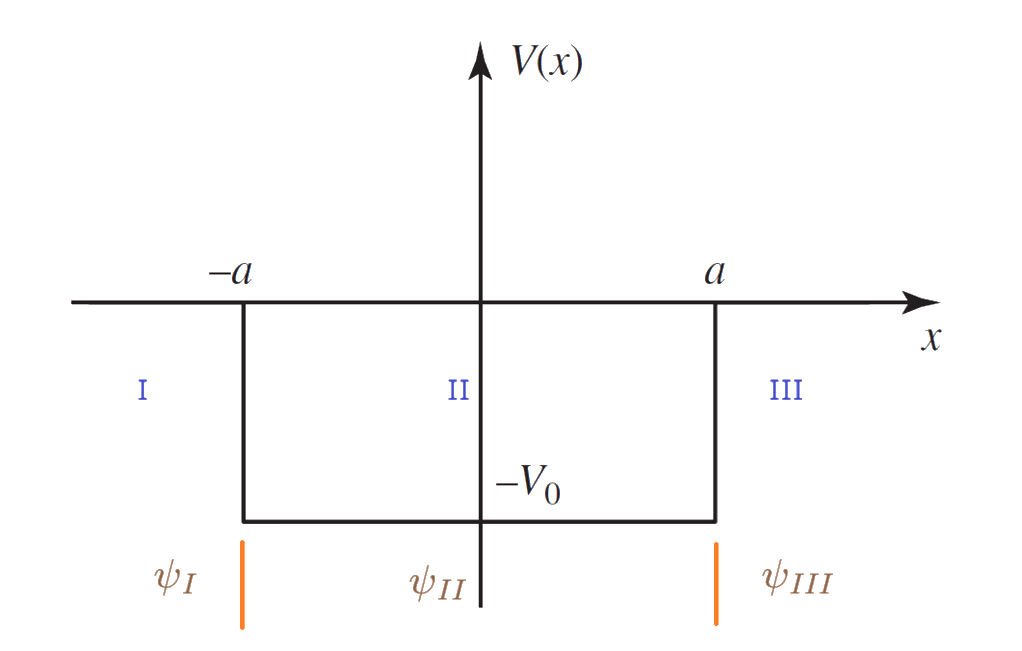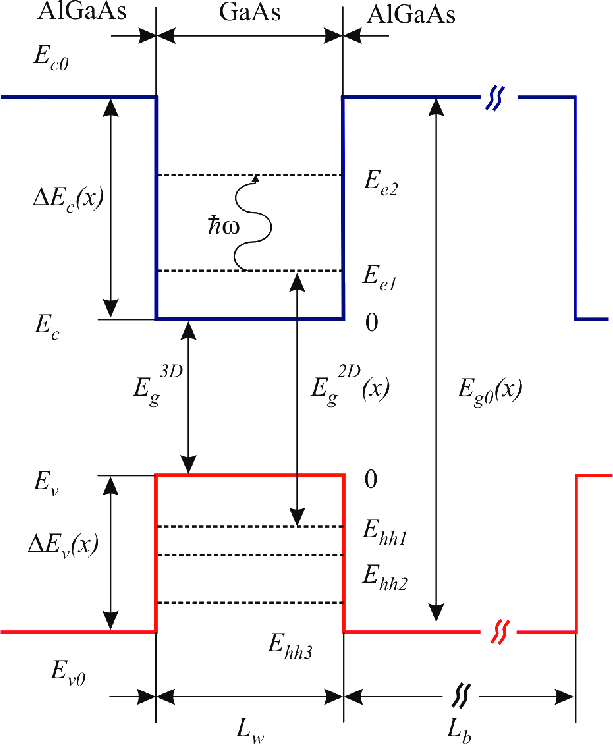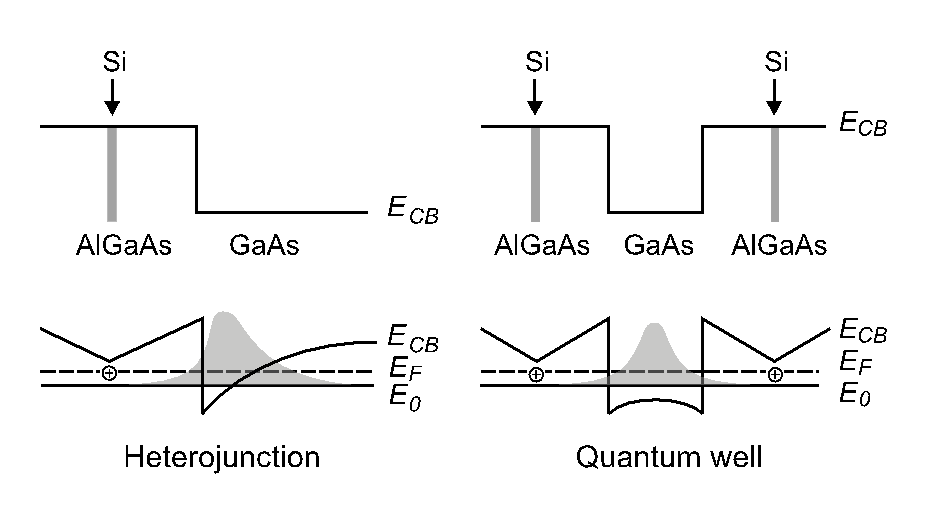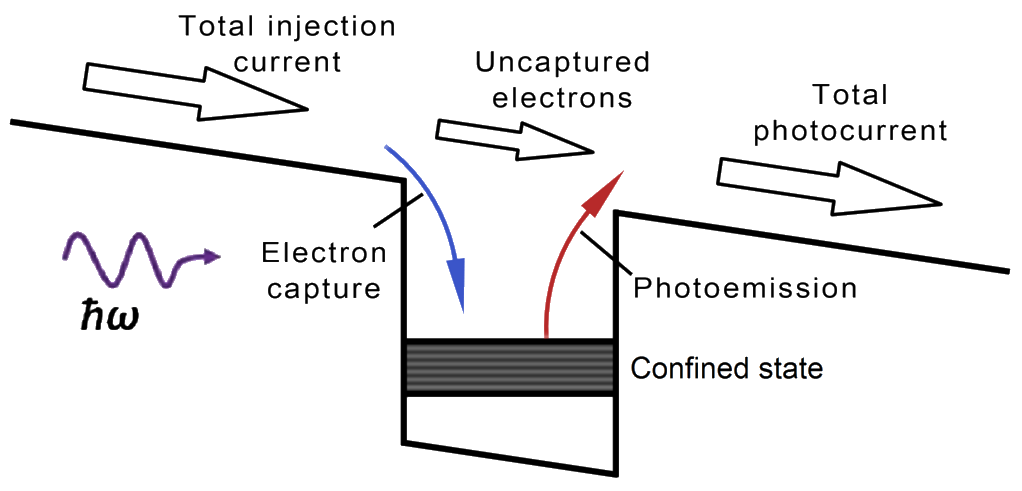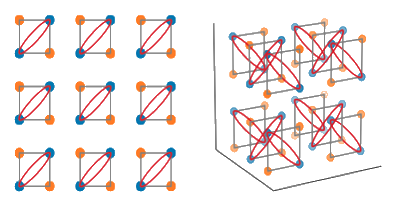\(\hat H\psi_n=E_n\psi_n,\;\left\{\begin{array}{l}\psi_n(x)=\sqrt{\frac2a}\sin(\frac{n\pi x}a)\\E_n=\frac{n^2\pi^2\hslash^2}{2ma^2}\end{array}\right.,\;n=1,2,3,\cdots\)
\(\int_0^a\psi_m^\ast(x)\psi_n(x)dx=\delta_{mn}\)
\(\psi(x)=\sum_nc_n\psi_n(x)\)
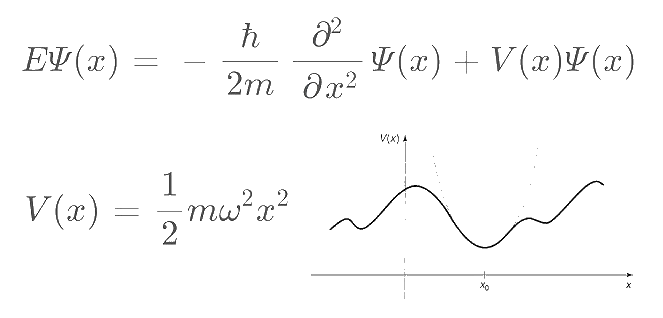
\(V(x)=\frac12m\omega^2x^2\)
Hooke's law - Spring potential energy
\(V(x)=\frac12kx^2\)
\(\omega=\sqrt{\frac km}\)
\(-\frac{\hslash^2}{2m}\frac{d^2\psi_n}{dx^2}+\frac12m\omega^2x^2\psi_n=E_n\psi_n\)
General, Common
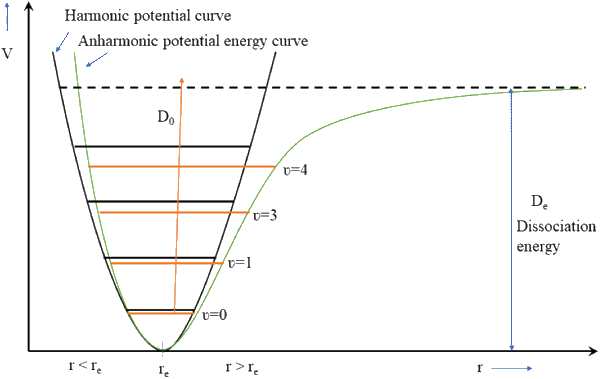

\(V(x)=\underbrace{V(x_0)}_{\equiv0}=\underbrace{V'(x_0)}_{=0}(x-x_0)+\frac12V''(x_0){(x-x_0)}^2+\underbrace\cdots_{anharmonic\;term\;(effect)}\)
\(x_0\simeq x\), near equilibrium
\(\frac{p^2}{2m}+\frac12m\omega^2x^2\psi=E\psi\)
\(\left\{\begin{array}{l}a_+\equiv\frac1{\sqrt{2m\hslash\omega}}(-ip+m\omega x)\\a_-\equiv\frac1{\sqrt{2m\hslash\omega}}(+ip+m\omega x)\end{array}\right.\)
\(a_-a_+=\frac1{2m\hslash\omega}(+ip+m\omega x)(-ip+m\omega x)\)
\(=\frac1{2m\hslash\omega}(p^2+m^2\omega^2x^2+im\omega px-im\omega xp)\)
\(\lbrack x,p\rbrack=xp-px\) "commutator"
\(\lbrack x,x\rbrack=x^2-x^2=0\)
\(\lbrack x,p\rbrack f(x)=xpf(x)-pxf(x)\)
\(=x\cdot\fracℏi\frac d{dx}f(x)-\fracℏi\frac d{dx}(xf(x))\)
\(=\cancel{x\cdot\fracℏi\frac{df(x)}{dx}}-\fracℏif(x)-\cancel{\fracℏi\cdot x\cdot\frac{df(x)}{dx}}\)
\(=i\hslash f(x)\)
\(\lbrack x,p\rbrack=i\hslash\)
\(a_-a_+=\frac1{2m\hslash\omega}(p^2+m^2\omega^2x^2+im\omega px-im\omega xp)\)
\(=\frac1{2m\hslash\omega}(p^2+m^2\omega^2x^2-im\omega\lbrack x,p\rbrack)\)
\(=\frac1{2m\hslash\omega}(p^2+m^2\omega^2x^2+m\hslash\omega)\)
\(\frac{p^2}{2m}+\frac12m\omega^2x^2\psi=E\psi\)
\(\underbrace{\frac1{2m}(p^2+m^2\omega^2x^2)}_\hat H\psi=E\psi\)
\(a_-a_+=\frac1{2m\hslash\omega}(p^2+m^2\omega^2x^2+m\hslash\omega)\)
\(=\frac1{2m\hslash\omega}(p^2+m^2\omega^2x^2)+\frac{1\cdot\cancel{m\hslash\omega}}{2\cdot\cancel{m\hslash\omega}}\)
\(=\frac1{\hslash\omega}\hat H+\frac12,\;\because\underbrace{\frac1{2m}(p^2+m^2\omega^2x^2)}_\hat H\psi=E\psi\)
\(\Rightarrow a_-a_+=\frac1{\hslash\omega}\hat H+\frac12\)
\(\Rightarrow \hat H=\hslash\omega(a_-a_+-\frac12)\)
\(a_-a_+=\frac1{2m\hslash\omega}(+ip+m\omega x)(-ip+m\omega x)\)
\(=\frac1{2m\hslash\omega}(p^2+m^2\omega^2x^2+im\omega px-im\omega xp)\)
\(=\frac1{2m\hslash\omega}(p^2+m^2\omega^2x^2-im\omega\lbrack x,p\rbrack)\)
\(=\frac1{2m\hslash\omega}(p^2+m^2\omega^2x^2+m\hslash\omega)\)
\(=\frac1{2m\hslash\omega}(p^2+m^2\omega^2x^2)+\frac{1\cdot\cancel{m\hslash\omega}}{2\cdot\cancel{m\hslash\omega}}\)
\(=\frac1{\hslash\omega}\hat H+\frac12,\;\because\frac1{2m}(p^2+m^2\omega^2x^2)=\hat H\)
\(\because a_-a_+=\frac1{\hslash\omega}\hat H+\frac12\)
\(\Rightarrow \hat H=\hslash\omega(a_-a_+-\frac12)\)
In quantum mechanics, the commutator of the position operator (x) and the momentum operator (p) is a fundamental concept. It represents the non-commutativity of these two operators, meaning the order in
which they are applied to a wave function matters. The commutator [x, p] is defined as xp - px, and its value is equal to iħ (where i is the imaginary unit and ħ is the reduced Planck constant).
similarity
\(a_+a_-=\frac1{2m\hslash\omega}(-ip+m\omega x)(+ip+m\omega x)\)
\(=\frac1{2m\hslash\omega}(p^2+m^2\omega^2x^2-im\omega px+im\omega xp)\)
\(=\frac1{2m\hslash\omega}(p^2+m^2\omega^2x^2+im\omega\lbrack x,p\rbrack)\)
\(=\frac1{2m\hslash\omega}(p^2+m^2\omega^2x^2-m\hslash\omega)\)
\(=\frac1{2m\hslash\omega}(p^2+m^2\omega^2x^2)-\frac{1\cdot\cancel{m\hslash\omega}}{2\cdot\cancel{m\hslash\omega}}\)
\(=\frac1{\hslash\omega}\hat H-\frac12\)
\(\because a_+a_-=\frac1{\hslash\omega}\hat H-\frac12\)
\(\Rightarrow \hat H=\hslash\omega(a_+a_-+\frac12)\)
\(\left\{\begin{array}{l}\hslash\omega(a_-a_+-\frac12)\psi=E\psi\\\hslash\omega(a_+a_-+\frac12)\psi=E\psi\end{array}\right.\)
\(\lbrack a_-,a_+\rbrack=a_-a_+-a_+a_-=1\)
\(\left\{\begin{array}{l}\lbrack x,p\rbrack=i\hslash\\\lbrack a_-,a_+\rbrack=1\end{array}\right.\)
\(\left\{\begin{array}{l}\lbrack x^2,p\rbrack=?\\\lbrack x,p^2\rbrack=?\\\lbrack x^2,p^2\rbrack=?\end{array}\right.\)
(1) \(\lbrack x^2,p\rbrack=x\lbrack x,p\rbrack+\lbrack x,p\rbrack x\)
\(=xi\hslash+i\hslash x\)
\(=2i\hslash x\)
\(\therefore\lbrack x^n,p\rbrack=n\cdot i\hslash x^{n-1}\)
(2) \(\lbrack x,p^2\rbrack=\lbrack x,p\rbrack p+p\lbrack x,p\rbrack\)
\(=i\hslash p+pi\hslash\)
\(=2i\hslash p\)
\(\therefore\lbrack x,p^n\rbrack=n\cdot i\hslash p^{n-1}\)
(3) Using commutator identities,
To get past where you got, all you really have to do is use \(\lbrack x,p\rbrack=i\hslash\) once.
\(\lbrack x^2,p^2\rbrack=x\lbrack x,p^2\rbrack+\lbrack x,p^2\rbrack x\)
\(=x(\lbrack x,p\rbrack p+p\lbrack x,p\rbrack)+(\lbrack x,p\rbrack p+p\lbrack x,p\rbrack)x\)
\(=x\lbrack x,p\rbrack p+xp\lbrack x,p\rbrack+\lbrack x,p\rbrack px+p\lbrack x,p\rbrack x\)
\(=xi\hslash p+xpi\hslash+i\hslash px+pi\hslash x\)
\(=2i\hslash(xp+px)\)
\(=2i\hslash(xp+(xp-i\hslash))\)
\(=4i\hslash xp+2\hslash^2\)
\(\lbrack x,p\rbrack=xp-px=i\hslash\)
\(-(xp-px)=-i\hslash\)
\(px-xp=-i\hslash=\lbrack p,x\rbrack\)
\(px=xp-i\hslash\)
\(\left\{\begin{array}{l}\lbrack A,B\rbrack=AB-BA\\\lbrack A,BC\rbrack=\lbrack A,B\rbrack C+B\lbrack A,C\rbrack\\\lbrack AB,C\rbrack=A\lbrack B,C\rbrack+\lbrack A,C\rbrack B\end{array}\right.\)
\([AB,C] = (AB)C - C(AB) = ABC - CAB\)
Now, let's look at the right-hand side. The RHS has two terms: \(A[B,C]\) and \([A,C]B\)
\(A[B,C] = A(BC - CB) = ABC - ACB\)
\([A,C]B = (AC-CA)B = ACB - CAB\)
So in fact, the correct formula looks like:
\(\begin{align} A[B,C]+[A,C]B&= ABC - ACB + ACB - CAB\\ & = ABC - CAB \\ & = [AB,C] \end{align}\)
So, \([AB,C] = A[B,C]+[A,C]B\)
\([A,BC]=A(BC)-(BC)A=ABC-BCA\)
Now, let's look at the right-hand side. The RHS has two terms: \(B[A,C]\) and \([A,B]C\)
\(B[A,C]=B(AC-CA)=BAC-BCA\)
\([A,B]C=(AB-BA)C=ABC-BAC\)
So in fact, the correct formula looks like:
\(\begin{align} B[A,C]+[A,B]C&=BAC-BCA+ABC-BAC\\ & =ABC-BCA \\ & = [A,BC] \end{align}\)
So, \([A,BC] = B[A,C]+[A,B]C\)
\(\left\{\begin{array}{l}\lbrack x,p\rbrack=i\hslash\\\lbrack x^2,p\rbrack=\lbrack x\cdot x,p\rbrack=x\lbrack x,p\rbrack+\lbrack x,p\rbrack x=i\hslash x+i\hslash x=2i\hslash x\\\lbrack
x^3,p\rbrack=\lbrack x\cdot x^2,p\rbrack=x\lbrack x^2,p\rbrack+\lbrack x,p\rbrack x^2=2i\hslash x\cdot x+i\hslash x^2=3i\hslash x^2\\\lbrack x^4,p\rbrack=\lbrack x\cdot x^3,p\rbrack=x\lbrack
x^3,p\rbrack+\lbrack x,p\rbrack x^3=3i\hslash x^2\cdot x+i\hslash x^3=4i\hslash x^3\end{array}\right.\)
\(\therefore\lbrack x^n,p\rbrack=\lbrack x\cdot x^{n-1},p\rbrack=ni\hslash x^{n-1}\)
\(\left\{\begin{array}{l}\lbrack x,p\rbrack=i\hslash\\\lbrack x,p^2\rbrack=\lbrack x,p\cdot p\rbrack=p\lbrack x,p\rbrack+\lbrack x,p\rbrack p=i\hslash p+i\hslash p=2i\hslash p\\\lbrack
x,p^3\rbrack=\lbrack x,p^2\cdot p\rbrack=p^2\lbrack x,p\rbrack+\lbrack x,p^2\rbrack p=i\hslash p^2+2i\hslash p\cdot p=3i\hslash p^2\\\lbrack x,p^4\rbrack=\lbrack x,p^3\cdot p\rbrack=p^3\lbrack
x,p\rbrack+\lbrack x,p^3\rbrack p=i\hslash p^3+3i\hslash p^2\cdot p=4i\hslash p^3\end{array}\right.\)
\(\therefore\lbrack x,p^n\rbrack=\lbrack x,p^{n-1}p\rbrack=ni\hslash p^{n-1}\)
Generalizations
\(\lbrack F(\vec x),p_i\rbrack=i\hslash\frac{\partial F(\vec x)}{\partial x_i};\qquad\lbrack x_i,F(\vec p)\rbrack=i\hslash\frac{\partial F(\vec p)}{\partial p_i}.\)
using \(C_{n+1}^{k}=C_{n}^{k}+C_{n}^{k-1}\), it can be shown that by mathematical induction
\(\left[\widehat x^n,\widehat p^m\right]=\sum_{k=1}^{\min\left(m,n\right)}\frac{-\left(-i\hslash\right)^kn!m!}{k!\left(n-k\right)!\left(m-k\right)!}\widehat x^{n-k}\widehat
p^{m-k}=\sum_{k=1}^{\min\left(m,n\right)}\frac{\left(i\hslash\right)^kn!m!}{k!\left(n-k\right)!\left(m-k\right)!}\widehat p^{m-k}\widehat x^{n-k}\)
generally known as McCoy's formula.
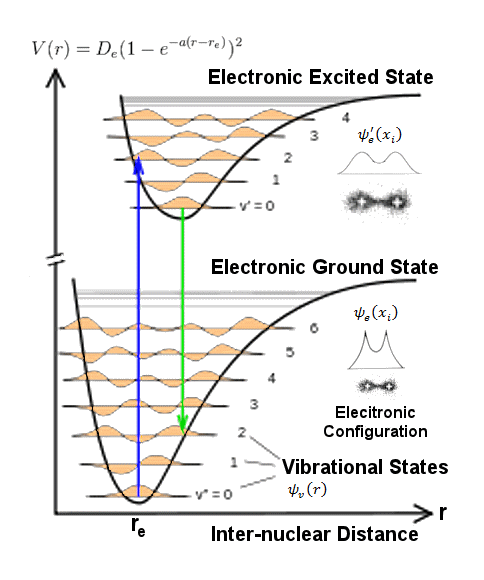
\(-\frac{\hslash^2}{2m}\frac{d^2\psi}{dx^2}+\frac12m\omega^2x^2\psi=E\psi\)
\(a_\pm\equiv\frac1{\sqrt{2m\hslash\omega}}(\mp ip+m\omega x)\)
\(\lbrack x,p\rbrack=i\hslash\)
\(\lbrack a_-,a_+\rbrack=1\)
\(\lbrack A,B\rbrack=AB-BA\)
\(H\psi_n=E_n\psi_n\)
\(H=\hslash\omega(a_+a_-+\frac12)\)
\(H=\hslash\omega(a_-a_+-\frac12)\)
if \(\psi\) is a solution with eigenvalue \(E\), \(H\psi=E\psi\)
then \(a_+\psi\) is a solution too, with eigenvalue \(E+\hslash\omega\)
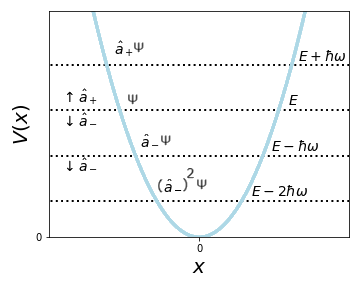
Proof: \(H(a_+\psi)\)
\(=(\hslash\omega(a_+a_-+\frac12))(a_+\psi)\)
\(=\hslash\omega(a_+a_-)(a_+\psi)+\frac12\hslash\omega(a_+\psi)\)
\(=\hslash\omega(a_+a_-a_+\psi)+\frac12\hslash\omega(a_+\psi)\)
\(=a_+(\hslash\omega(a_-a_+\psi+\frac12\psi))\)
\(\because\lbrack a_-,a_+\rbrack=1\;\Rightarrow\;a_-a_+-a_+a_-=1\;\Rightarrow\;a_-a_+=a_+a_-+1\)
\(=a_+(\hslash\omega((a_+a_-+1)\psi+\frac12\psi))\)
\(=a_+(\underbrace{\hslash\omega((a_+a_-+\frac12)}_H\psi+1\cdot\psi))\)
\(=a_+(H\psi+\hslash\omega\psi)\)
\(=a_+(E\psi+\hslash\omega\psi)\)
\(=(E+\hslash\omega)(a_+\psi)\)
\(H(a_-\psi)\)
\(=(\hslash\omega(a_-a_+-\frac12))(a_-\psi)\)
\(=\hslash\omega(a_-a_+)(a_-\psi)-\frac12\hslash\omega(a_-\psi)\)
\(=\hslash\omega(a_-a_+a_-\psi)-\frac12\hslash\omega(a_-\psi)\)
\(=a_-(\hslash\omega(a_+a_-\psi-\frac12\psi))\)
\(\because\lbrack a_+,a_-\rbrack=-1\;\Rightarrow\;a_+a_--a_-a_+=-1\;\Rightarrow\;a_+a_-=a_-a_+-1\)
\(=a_-(\hslash\omega((a_-a_+-1)\psi-\frac12\psi))\)
\(=a_-(\underbrace{\hslash\omega((a_-a_+-\frac12)}_H\psi-1\cdot\psi))\)
\(=a_-(H\psi-\hslash\omega\psi)\)
\(=a_-(E\psi-\hslash\omega\psi)\)
\(=(E-\hslash\omega)(a_-\psi)\)
\(\left\{\begin{array}{l}H(a_+\psi)=(E+\hslash\omega)(a_+\psi)\\H(a_-\psi)=(E-\hslash\omega)(a_-\psi)\end{array}\right.\)
\(\left\{\begin{array}{l}H(a_+\psi)=(E+\hslash\omega)(a_+\psi)\\H(a_+^2\psi)=(E+2\hslash\omega)(a_+\psi)\\H(a_+^3\psi)=(E+3\hslash\omega)(a_+\psi)\end{array}\right.\)
\(\left\{\begin{array}{l}H(a_-\psi)=(E-\hslash\omega)(a_-\psi)\\H(a_-^2\psi)=(E-2\hslash\omega)(a_-\psi)\\H(a_-^3\psi)=(E-3\hslash\omega)(a_-\psi)\end{array}\right.\)
if \(\psi\) is a solution with eigenvalue \(E\), \(H\psi=E\psi\)
then \(a_+\psi\) is a solution too, with eigenvalue \(E+\hslash\omega\)
then \(a_-\psi\) is a solution too, with eigenvalue \(E-\hslash\omega\)
\(E_n>0\)
\(a_+\): raising operator
\(a_-\): lowering operator
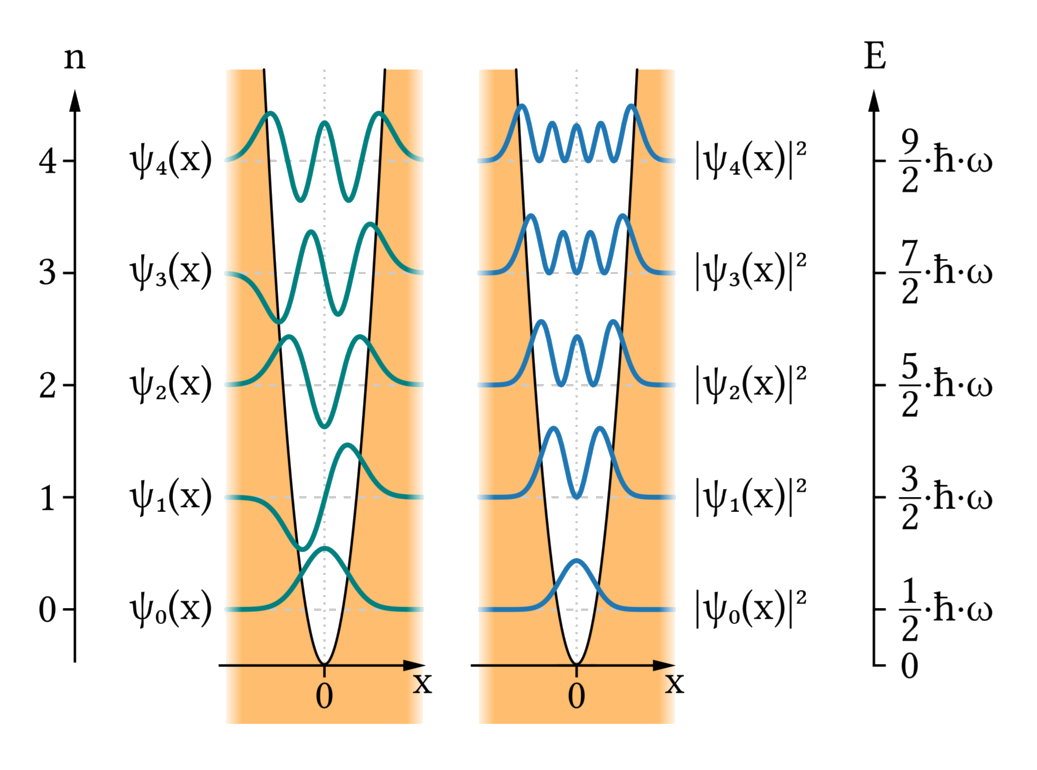
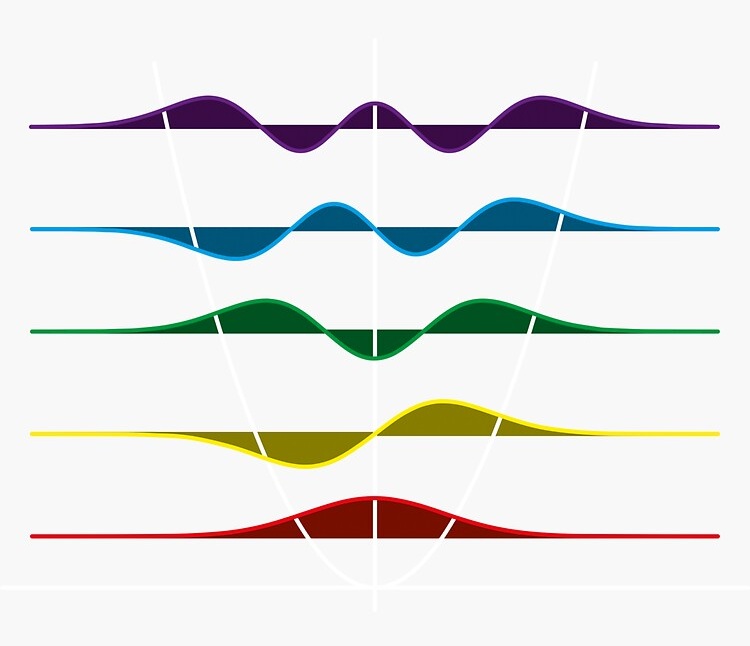
\(a_\pm\equiv\frac1{\sqrt{2m\hslash\omega}}(\mp ip+m\omega x)\)
\(H\psi_0=E_0\psi_0\)
\(a_-\psi_0=0\)
\(a_-=\frac1{\sqrt{2m\hslash\omega}}(+ip+m\omega x)\)
\((i\fracℏi\frac d{dx}+m\omega x)\psi_0(x)=0\)
\(\frac{d\psi_0}{dx}=-\frac{m\omega}ℏx\psi_0\)
\(\frac{d\psi_0}{\psi_0}=-\frac{m\omega}ℏxdx\)
\(\ln(\psi_0)=-\frac{m\omega x^2}{2\hslash}+c\)
\(\Rightarrow\psi_0(x)=Ae^{-\frac{m\omega}{2\hslash}x^2}\)
\(\because\int_{-\infty}^\infty\left|\psi_0(x)\right|^2\operatorname dx=1\)
\(\Rightarrow A={(\frac{m\omega}{\pi\hslash})}^\frac14\)
\(\Rightarrow\psi_0(x)={(\frac{m\omega}{\pi\hslash})}^\frac14e^{-\frac{m\omega}{2\hslash}x^2}\)
\(\hslash\omega(a_+a_-+\frac12)\psi_0=E_0\psi_0\)
\(\because a_-\psi_0=0\;\Rightarrow\;a_+a_-\psi_0=0\;\Rightarrow\;\hslash\omega(a_+a_-)\psi_0=0\)
\(\frac12\hslash\omega\psi_0=E_0\psi_0\)
\(\therefore\psi_0\;\rightarrow\;E_0=\frac12\hslash\omega\)
\(\left\{\begin{array}{l}\psi_n=A_n{(a_+)}^n\psi_0\;(x)\\E_n=(n+\frac12)\hslash\omega\end{array}\right.\)
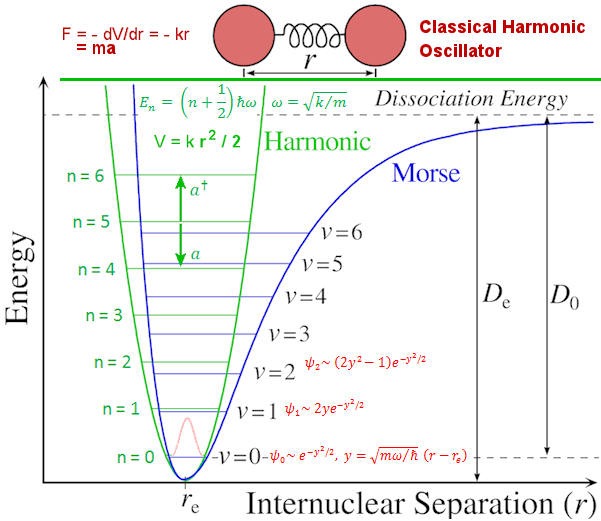
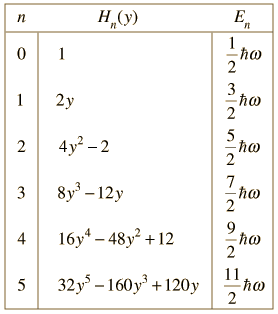
\(\psi_1\propto x\cdot e^{-\frac{m\omega}{2\hslash}x^2}\)
\(\psi_2\propto x^2\cdot e^{-\frac{m\omega}{2\hslash}x^2}\)
\(\Psi(x,t)=\sum_nc_n\psi_ne^{-\frac{iE_n}ℏt}\)
\(\left\langle\hat Q(x,p)\right\rangle=\int\Psi^\ast Q\Psi dx\)
\(\left\{\begin{array}{l}a_+\psi_n=c_n\psi_{n+1}\\a_-\psi_n=d_n\psi_{n-1}\end{array}\right.\)
\(\int_{-\infty}^{+\infty}f^\ast(x)(a_+g(x))\operatorname dx\)
\(=\int_{-\infty}^{+\infty}f^\ast(-i\fracℏi\frac d{dx}+m\omega x)g\operatorname dx\)
\(\int_{-\infty}^{+\infty}f^\ast(-\hslash\frac{dg}{dx})dx=-\hslash(\cancel{\left.f^\ast g\right|_{-\infty}^\infty}-\int\frac{df^\ast}{dx}gdx)\)
\(=\hslash\int\frac{df^\ast}{dx}gdx\)
\(\Rightarrow\int_{-\infty}^{+\infty}f^\ast(-i\fracℏi\frac d{dx}+m\omega x)g\operatorname dx\)
\(=\int_{-\infty}^{+\infty}({(i\fracℏi\frac d{dx}+m\omega x)f)}^\ast gdx\)
\(=\int_{-\infty}^{+\infty}{(a_-f)}^\ast gdx\)
\(\int_{-\infty}^{+\infty}f^\ast(x)(a_+g(x))\operatorname dx=\int_{-\infty}^{+\infty}{(a_-f(x))}^\ast g(x)dx\)
\(H=\hslash\omega(a_+a_-+\frac12)=\hslash\omega(a_-a_+-\frac12)\)
\(H\psi_n=E_n\psi_n\)
\(\hslash\omega(a_+a_-+\frac12)\psi_n=E_n\psi_n=(n+\frac12)\hslash\omega\psi_n\)
\(\hslash\omega(a_+a_-+\cancel{\frac12})\psi_n=(n+\cancel{\frac12})\hslash\omega\psi_n\)
\(\hslash\omega(a_-a_+-\frac12)\psi_n=E_n\psi_n=(n+\frac12)\hslash\omega\psi_n=\lbrack(n+1)-\frac12\rbrack\hslash\omega\psi_n\)
\(\hslash\omega(a_-a_+-\cancel{\frac12})\psi_n=\lbrack(n+1)-\cancel{\frac12}\rbrack\hslash\omega\psi_n\)
number operator \(\left\{\begin{array}{l}a_+a_-\psi_n=n\psi_n\\a_-a_+\psi_n=(n+1)\psi_n\end{array}\right.\)
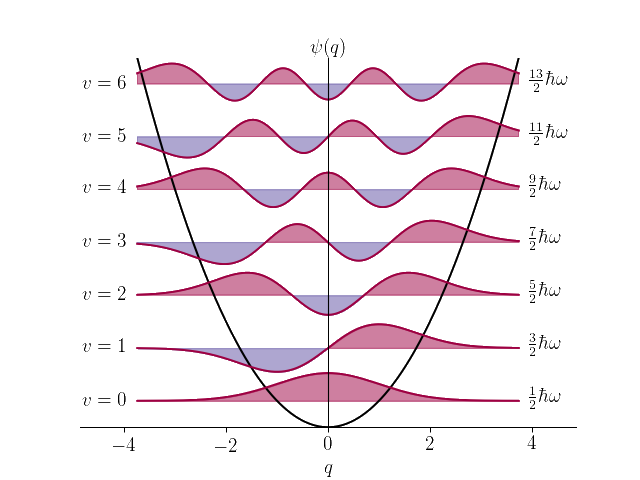
\(\left\{\begin{array}{l}a_+\psi_n=c_n\psi_{n+1}\\a_-\psi_n=d_n\psi_{n-1}\end{array}\right.\)
number operator \(\left\{\begin{array}{l}a_+a_-\psi_n=n\psi_n\\a_-a_+\psi_n=(n+1)\psi_n\end{array}\right.\)
\(\because a_+\psi_n=c_n\psi_{n+1}\)
\(\int_{-\infty}^\infty{(a_+\psi_n)}^\ast(a_+\psi_n)\operatorname dx=\int_{-\infty}^\infty{(c_n\psi_{n+1})}^\ast(c_n\psi_{n+1})\operatorname dx\)
\(=\int_{-\infty}^\infty{(a_-a_+\psi_n)}^\ast\psi_n\operatorname dx\)
\(=\int_{-\infty}^\infty{(n+1)\psi_n}^\ast\psi_n\operatorname dx\)
\(=n+1\)
\(\int_{-\infty}^\infty{(c_n\psi_{n+1})}^\ast(c_n\psi_{n+1})\operatorname dx=\left|c_n\right|^2\underbrace{\int_{-\infty}^\infty\left|\psi_{n+1}\right|^2dx}_{=1}\)
\(=\left|c_n\right|^2\)
\(\therefore c_n=\sqrt{n+1}\)
\(\because a_-\psi_n=d_n\psi_{n-1}\)
\(\int_{-\infty}^\infty{(a_-\psi_n)}^\ast(a_-\psi_n)\operatorname dx=\int_{-\infty}^\infty{(d_n\psi_{n-1})}^\ast(d_n\psi_{n-1})\operatorname dx\)
\(=\int_{-\infty}^\infty{(a_+a_-\psi_n)}^\ast\psi_n\operatorname dx\)
\(=\int_{-\infty}^\infty{n\cdot\psi_n}^\ast\psi_n\operatorname dx\)
\(=n\)
\(\int_{-\infty}^\infty{(d_n\psi_{n-1})}^\ast(d_n\psi_{n-1})\operatorname dx=\left|d_n\right|^2\underbrace{\int_{-\infty}^\infty\left|\psi_{n-1}\right|^2dx}_{=1}\)
\(=\left|d_n\right|^2\)
\(\therefore d_n=\sqrt n\)
\(\left\{\begin{array}{l}c_n=\sqrt{n+1}\\d_n=\sqrt n\end{array}\right.\)
\(\Rightarrow\left\{\begin{array}{l}a_+\psi_n=\sqrt{n+1}\psi_{n+1}\\a_-\psi_n=\sqrt n\psi_{n-1}\end{array}\right.\)
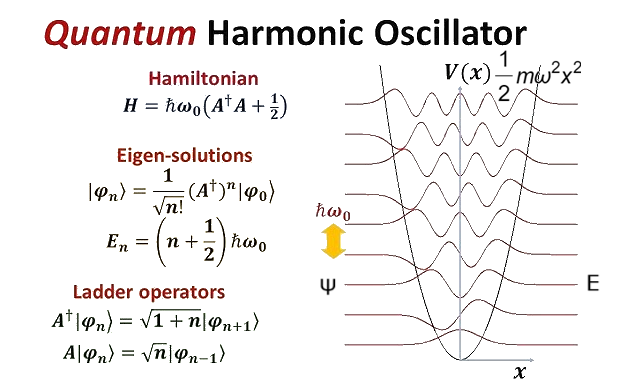
\(a_+\psi_n=\sqrt{n+1}\psi_{n+1}\;\Rightarrow\psi_{n+1}=\frac{a_+}{\sqrt{n+1}}\psi_n\)
\(\psi_1=a_+\psi_0\)
\(\psi_2=\frac1{\sqrt2}a_+\psi_1=\frac1{\sqrt2}{(a_+)}^2\psi_0\)
\(\psi_3=\frac1{\sqrt3}a_+\psi_2=\frac1{\sqrt3}\frac1{\sqrt2}{(a_+)}^2\psi_1=\frac1{\sqrt3}\frac1{\sqrt2}\frac1{\sqrt1}{(a_+)}^3\psi_0\)
\(\psi_n(x)=\frac1{\sqrt{n!}}{(a_+)}^n\psi_0(x)\)
\(\Rightarrow\left\{\begin{array}{l}\psi_n(x)=\frac1{\sqrt{n!}}{(a_+)}^n\psi_0(x)\;\Rightarrow\vert n\rangle=\frac1{\sqrt{n!}}{(a_+)}^n\vert0\rangle\\E_n=(n+\frac12)\hslash\omega\end{array}\right.\)
\(\langle\hat Q(x,p)\rangle=?\)
\(\langle x\rangle=\langle n\vert x\vert n\rangle=\int_{-\infty}^\infty\psi_n^\ast(x)\cdot x\cdot\psi_n(x)\operatorname dx=?\)
number operator \(\left\{\begin{array}{l}a_+a_-\psi_n=n\psi_n\\a_-a_+\psi_n=(n+1)\psi_n\end{array}\right.\)
\(\int_{-\infty}^\infty\psi_m^\ast\psi_n\operatorname dx,\;m\neq n\)
\(=\frac1n\int_{-\infty}^\infty\psi_m^\ast n\psi_n\operatorname dx\)
\(=\frac1n\int_{-\infty}^\infty\psi_m^\ast(a_+a_-\psi_n)\operatorname dx\)
\(=\frac1n\int_{-\infty}^\infty\psi_m^\ast a_+(a_-\psi_n)\operatorname dx\)
\(=\frac1n\int_{-\infty}^\infty\underbrace{\psi_m^\ast a_+}(a_-\psi_n)\operatorname dx\)
\(=\frac1n\int_{-\infty}^\infty\underbrace{{(a_-\psi_m)}^\ast(a_-}\psi_n)\operatorname dx\)
\(=\frac1n\int_{-\infty}^\infty{(a_+a_-\psi_m)}^\ast(\psi_n)\operatorname dx\)
\(=\frac1n\int_{-\infty}^\infty{m\psi_m}^\ast\psi_n\operatorname dx\)
\(\Rightarrow\int_{-\infty}^\infty\psi_n^\ast\psi_n\operatorname dx=\frac mn\int_{-\infty}^\infty\psi_m^\ast\psi_n\operatorname dx\)
\((m-n)\int_{-\infty}^\infty\psi_m^\ast\psi_n\operatorname dx=0\)
\(\therefore\int_{-\infty}^\infty\psi_m^\ast\psi_n\operatorname dx=0\)
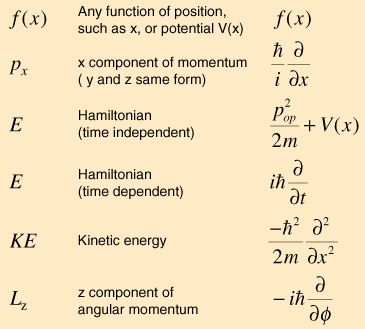
\(\langle x\rangle=?\)
\(\left\{\begin{array}{l}a_+=\frac1{\sqrt{2m\hslash\omega}}(-ip+m\omega x)\;\;\cdots\;(\alpha)\\a_-=\frac1{\sqrt{2m\hslash\omega}}(+ip+m\omega x)\;\;\cdots\;(\beta)\end{array}\right.\)
\((\alpha)+(\beta)\;\Rightarrow\;x=\frac1{2m\omega}\sqrt{2m\hslash\omega}(a_++a_-)\)
\(\therefore x=\sqrt{\fracℏ{2m\omega}}(a_++a_-)\)
\((\beta)-(\alpha)\;\Rightarrow\;p=\frac1{2i}\sqrt{2m\hslash\omega}(a_--a_+)\)
\(\therefore p=i\sqrt{\frac{m\hslash\omega}2}(a_+-a_-)\)
\(\langle x\rangle=\int_{-\infty}^\infty\psi_n^\ast\cdot x\cdot\psi_n\operatorname dx,\;and\;applied\;x=\sqrt{\fracℏ{2m\omega}}(a_++a_-)\)
\(=\int_{-\infty}^\infty\psi_n^\ast(\sqrt{\fracℏ{2m\omega}}(a_++a_-))\psi_n\operatorname dx\)
\(=\sqrt{\fracℏ{2m\omega}}(\int_{-\infty}^\infty\psi_n^\ast a_+\psi_n\operatorname dx+\int_{-\infty}^\infty\psi_n^\ast a_-\psi_n\operatorname dx)\)
\(\Rightarrow\left\{\begin{array}{l}a_+\psi_n=\sqrt{n+1}\psi_{n+1}\\a_-\psi_n=\sqrt n\psi_{n-1}\end{array}\right.\)
\(=\sqrt{\fracℏ{2m\omega}}(\int_{-\infty}^\infty\psi_n^\ast\sqrt{n+1}\psi_{n+1}\operatorname dx+\int_{-\infty}^\infty\psi_n^\ast\sqrt n\psi_{n-1}\operatorname dx)\)
\(\langle x\rangle=0\) ◼
\(\langle x\rangle=0,\;\langle x^2\rangle=?\)
\(\because x=\sqrt{\fracℏ{2m\omega}}(a_++a_-)\)
\(x^2=\fracℏ{2m\omega}(a_++a_-)(a_++a_-)\)
\(=\fracℏ{2m\omega}(a_+^2+a_+a_-+a_-a_++a_-^2)\)
\(\langle x^2\rangle=\fracℏ{2m\omega}\int_{-\infty}^\infty\psi_n^\ast(a_+^2+a_+a_-+a_-a_++a_-^2)\psi_n\operatorname dx\)
\(=\fracℏ{2m\omega}\int_{-\infty}^\infty\psi_n^\ast(\underbrace{\cancel{a_+^2}}_{\psi_{n+2}}+a_+a_-+a_-a_++\underbrace{\cancel{a_-^2}}_{\psi_{n-2}})\psi_n\operatorname dx\)
\(=\fracℏ{2m\omega}\int_{-\infty}^\infty\psi_n^\ast(\underbrace{a_+a_-}_{\sqrt n\sqrt n}+\underbrace{a_-a_+}_{\sqrt{n+1}\sqrt{n+1}})\psi_n\operatorname
dx\;\because\left\{\begin{array}{l}a_+\psi_n=\sqrt{n+1}\psi_{n+1}\\a_-\psi_n=\sqrt n\psi_{n-1}\end{array}\right.\)
\(=\fracℏ{2m\omega}(2n+1)\) ◼
\(\langle V\rangle=\langle\frac12m\omega^2x^2\rangle\)
\(=\frac12m\omega^2\langle x^2\rangle\)
\(=\frac12m\omega^2\cdot\fracℏ{2m\omega}(2n+1)\)
\(=\frac12\hslash\omega(n+\frac12)\)
\(\therefore\langle V\rangle=\frac12E_n\)
\(\langle K\rangle=\frac1{2m}\langle p^2\rangle\)
